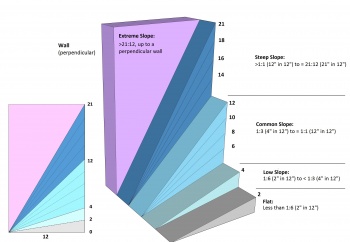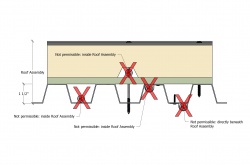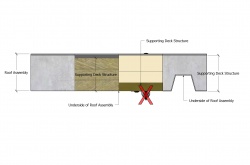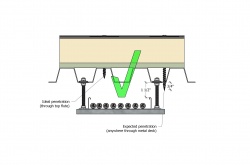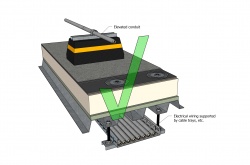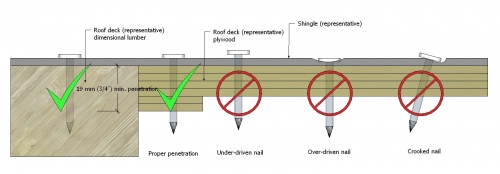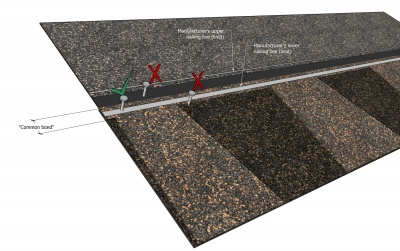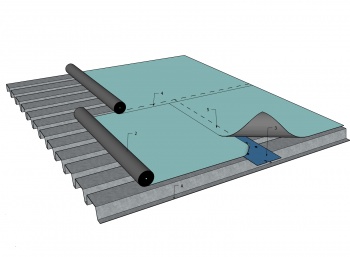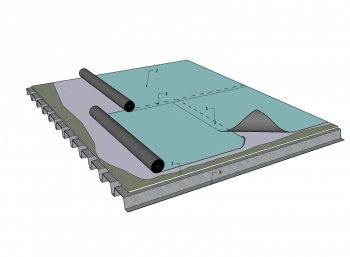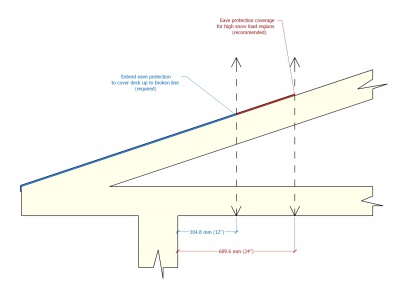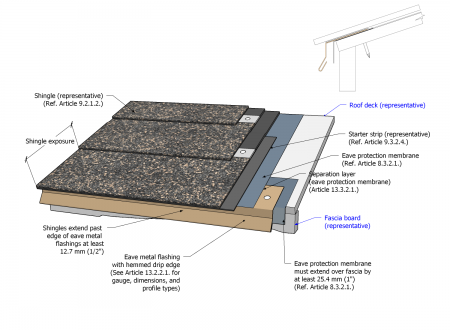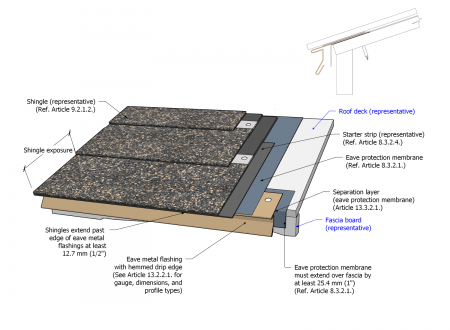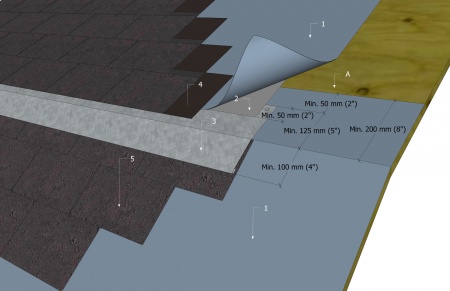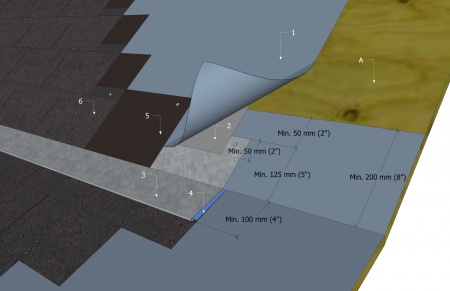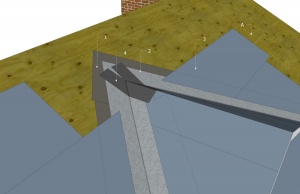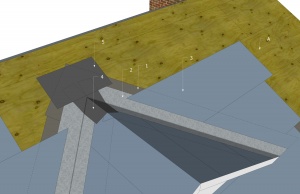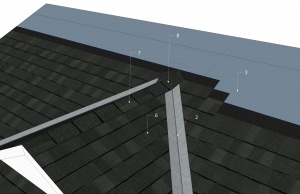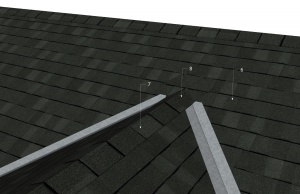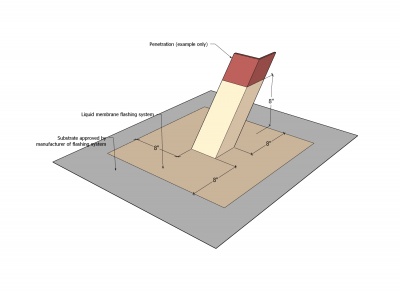(Draft) Asphalt Shingle Systems Standard
(Draft) Asphalt Shingle Systems Standard
Contents
- 1 Part 1 - General
- 1.1 Section 1.1. Design
- 1.2 Section 1.2. Reserved
- 1.3 Section 1.3. Application
- 1.3.1 1.3.1. Reserved
- 1.3.2 1.3.2. All Systems
- 1.3.3 1.3.3. Replacement and Alterations
- 1.3.3.1 1.3.3.1. General Requirements
- 1.3.3.2 1.3.3.2. Complete Roof System Replacement
- 1.3.3.3 1.3.3.3. Partial Roof Replacement
- 1.3.3.4 1.3.3.4. Converting from Cedar or Concrete Tiles to Asphalt Shingles
- 1.3.3.5 1.3.3.5. Tie-ins and Additions to Existing Roofing
- 1.3.3.6 1.3.3.6. Repairs and Modifications
- 1.3.4 1.3.4. Reserved
- 2 Part 2 - Supporting Structures: Decks and Walls
- 3 Part 3 - Securing the Roof Assembly
- 3.1 Section 3.1. Design
- 3.2 Section 3.2. Materials
- 3.3 Section 3.3. Application
- 4 Part 4 - Materials
- 5 Part 5 - Deck and Wall Overlays
- 6 Part 6 - Air and Vapour Controls
- 7 Part 7 - Insulation
- 8 Part 8 - Eave, Valley, and Field Underlayment
- 9 Part 9 - Roof Field (Shingle Systems)
- 9.1 Section 9.1. Design
- 9.2 Section 9.2. Materials
- 9.3 Section 9.3. Application
- 9.3.1 9.3.1. Guarantee Term Requirements
- 9.3.2 9.3.2. All Systems
- 9.3.2.1 9.3.2.1. Preparation of Substrate
- 9.3.2.2 9.3.2.2. Preparation of Roofing Materials
- 9.3.2.3 9.3.2.3. Reserved
- 9.3.2.4 9.3.2.4. General Requirements for Asphalt Shingle Application
- 9.3.2.5 9.3.2.5. Application on Slopes Less Than 1:3
- 9.3.2.6 9.3.2.6. Reserved
- 9.3.2.7 9.3.2.7. Changes in Slope
- 10 Part 10 - Perimeters and Walls
- 10.1 Section 10.1. Design
- 10.2 Section 10.2. Materials
- 10.3 Section 10.3. Application
- 10.3.1 10.3.1. Guarantee Term Requirements
- 10.3.2 10.3.2. All Systems
- 10.3.3 10.3.3. Reserved
- 10.3.4 10.3.4. Perimeter Details, Walls, and Openings
- 10.3.5 10.3.5. Valleys
- 10.3.5.1 10.3.5.1. Valley Protection
- 10.3.5.2 10.3.5.2. General Requirements for Valley Metal Flashing
- 10.3.5.3 10.3.5.3. Open Valleys
- 10.3.5.4 10.3.5.4. California Valleys
- 10.3.5.5 10.3.5.5. Woven Valleys
- 10.3.5.6 10.3.5.6. Closed (Cut) Valleys
- 10.3.5.7 10.3.5.7. Dead Valleys
- 10.3.5.8 10.3.5.8. Valley Changes in Slope
- 10.3.5.9 10.3.5.9. Valley Intersection with Ridge
- 10.3.6 10.3.6. Reserved
- 10.3.7 10.3.7. Intersections with Other Roof Systems
- 10.3.8 10.3.8. Reserved
- 11 Part 11 - Drainage
- 11.1 Section 11.1. Design
- 11.2 Section 11.2. Materials
- 11.3 Section 11.3. Application
- 11.3.1 11.3.1. Guarantee Term Requirements
- 11.3.2 11.3.2. All Systems
- 11.3.3 11.3.3. Drains and Membrane Gutters
- 11.3.3.1 11.3.3.1. Reserved
- 11.3.3.2 11.3.3.2. General Requirements for Cast-iron Roof Drains
- 11.3.3.3 11.3.3.3. Cast-iron Drains Installed with Lead Flashing
- 11.3.3.4 11.3.3.4. Cast-iron Drains Installed with Membrane Flashing
- 11.3.3.5 11.3.3.5. Cast-iron Roof Drain Retrofitting (Replacement Roofing)
- 11.3.3.6 11.3.3.6. Flanged Insert-type Roof Drains
- 11.3.3.7 11.3.3.7. Scuppers and Overflows
- 11.3.3.8 11.3.3.8. Membrane Gutters
- 11.3.3.9 11.3.3.9. External Gutters
- 12 Part 12 - Penetrations and Curbs
- 12.1 Section 12.1. Design
- 12.2 Section 12.2. Materials
- 12.3 Section 12.3. Application
- 12.3.1 12.3.1. Guarantee Term Requirements
- 12.3.2 12.3.2. All Systems
- 12.3.2.1 12.3.2.1. General Requirements for Flashing Penetrations
- 12.3.2.2 12.3.2.2. Reserved
- 12.3.2.3 12.3.2.3. Separation Between Penetration Flashings
- 12.3.2.4 12.3.2.4. Curbs
- 12.3.2.5 12.3.2.5. Air Vents
- 12.3.2.6 12.3.2.6. Liquid Membrane Flashing
- 12.3.2.7 12.3.2.7. Railings, Ladders, and Other Attached Structures
- 12.3.2.8 12.3.2.8. External Gutters
- 13 Part 13 - Linear Metal Flashing
- 13.1 Section 13.1. Design
- 13.1.1 13.1.1. General
- 13.1.2 13.1.2. Guarantee Term Requirements
- 13.1.3 13.1.3. All Systems
- 13.1.3.1 13.1.3.1. Scope and Function
- 13.1.3.2 13.1.3.2. Information Required in Specifications
- 13.1.3.3 13.1.3.3. Securement
- 13.1.3.4 13.1.3.4. Gauge, Dimension Limitations, and Seams
- 13.1.3.5 13.1.3.5. Fit and Finish
- 13.1.3.6 13.1.3.6. Cap and Counter-flashing
- 13.1.3.7 13.1.3.7. Intersections with Other Assemblies
- 13.2 Section 13.2. Materials
- 13.3 Section 13.3. Application
- 13.1 Section 13.1. Design
- 14 Part 14 - The Roof as a Platform
- 15 Notes to Standard
Division B - Standards
Water-shedding Roof Systems: Bituminous
Standard for Asphalt Shingle Roof Systems
This Standard is a consolidation of requirements previously published in the Roofing Practices Manual for Other Roofing Systems (Asphalt Shingles) (Tab 7). It is comprised of fourteen (14) Parts that contain the requirements, guiding principles, recommendations and informative materials necessary for a roof to qualify for a RoofStar 5-Year Guarantee or RoofStar 10-Year Guarantee.
Notes to the Standard are hyperlinked from each Part and can be read by using the link in the Table of Contents for the Standard. Highlighted text within the body of the Standard indicates revisions made within the last twelve (12) months.
This Standard follows a specific structure, incorporates defined terms, and utilizes coloured text to denote specific meaning; this is explained in Division A, Part 2, "Structure and Organization of RPM and Standards". When the requirements in this Standard conflict with other resources found either in this Manual or in manufacturer's published instructions, the rules for Authority and Conflict in Division A, Article 2.3.1.2. shall be applied.
Readers are advised to review relevant materials that can be accessed through the hyperlinks embedded in the body of text.
First Edition: October 18, 2019
Previous Edition: October 20, 2023
Current Edition: Adopted February 1, 2024
All changes to this Standard are effective
February 1, 2024
© RCABC 2024
No reproduction of this Standard, in whole or in part, is lawful without the expressed permission of the RCABC.
Part 1 - General
Section 1.1. Design
1.1.1. General
1.1.1.1. Scope
- The scope of this Part and the Standard shall be as described in Division A, Part 1.
1.1.1.2. Coverage and Limitations
- Coverage under the RoofStar Guarantee shall be as described in Division A, Article 3.2.1.2.
1.1.1.3. References
- In this Standard, all references to
- the "British Columbia Building Code" (the "Building Code", or the "Code"), to municipal or regional building codes or regulations, or to other standards, presume the current edition that is in force,
- materials mean those materials expressly accepted by the Guarantor, unless stated otherwise, and
- measurements are shown in metric units first, followed by Imperial values (typically in parentheses; see Division A, Article 2.1.3.2., "Measurements").
1.1.1.4. Definitions
- Words that appear in italics are defined in the Glossary. Additionally, the following terms are used in this Part and the Standard:
- Design Authority means the individual or firm responsible for the issuance of project specifications and details to which the project will be bid and constructed. When a Contractor designs a project, the Contractor is deemed to be the Design Authority.
- Finished roof system surface means the top surface of any roof system, inclusive of ballast or overburden.
- Grade-level waterproofing system means an insulated or uninsulated system, designed and constructed at grade with a sheet or liquid-applied membrane, to exclude water.
- Linear metal flashing means flashings cut and shaped from flat metal stock, to redirect water at roof perimeters and edges, or to control the flow of water in valleys and drainage spillways. Linear metal flashings also protect roof membranes from weathering and damage and provide an aesthetic finish to the roof system.
- Guarantor (used interchangeably with RGC) means the RCABC Guarantee Corporation, which offers the RoofStar Guarantee.
- Membrane system means the combination of field and flashing membranes which function together to waterproof underlying materials and systems.
- Waterproofing roof system means an insulated or uninsulated roof system, designed and constructed on roofs using a sheet or liquid-applied membrane, to exclude water. This type of system typically is installed on roof slopes less than 1:4 (3” in 12”).
- Water-shedding roof system means an insulated or uninsulated roof system, designed and constructed to shed water away from a structure, not to waterproof it. This type of system typically is installed on roof slopes greater than 1:4 (3” in 12”) but may be installed on slopes as low as 1:6 (2" in 12").
1.1.2. Guarantee Term Requirements
1.1.2.1. RoofStar 5-Year and RoofStar 10-year Guarantee
- To qualify for a RoofStar 5-year or RoofStar 10-year Guarantee, all projects shall comply with the requirements in this Part.
- In addition to Sentence (1), all projects shall comply with
- the project specifications and drawings, and
- the manufacturer's published installation requirements .
1.1.3. All Systems
1.1.3.1. Permitted Roof Systems
(See Note A-1.1.3.1.)
- This Standard applies to new construction, and to the partial or complete replacement of existing roofs, constructed with fibreglass-reinforced asphalt shingles.
1.1.3.2. Snow Loads
- In this Standard, a high snow load area is considered a regional area with a Specified Snow Load higher than 3.5 kPa (See Note A-1.1.3.2.).
- Roofs subject to high snow loads must be designed with a supporting deck structure thick enough to support the anticipated live loads, within the acceptable deflection limits defined by the "British Columbia Building Code".
- Consideration should be given to
- slope,
- entrances and exits,
- penetrations,
- valley construction,
- proper intake and exit ventilation, irrespective of snow cover and drifting, and
- penetrations and their functionality.
1.1.3.3. Ventilation
- Roofs that do not provide adequate ventilation do not qualify for a RoofStar Guarantee.
- The design and selection of the ventilation system is the responsibility of the Design Authority, and may be achieved by incorporating into the roof design both intake and exhaust vents, including (without limitation),
- eave vents,
- gable end vents,
- hip vents,
- static vents,
- ridge vents, or
- cupolas
- Attic (roof cavity) ventilation must meet the minimum requirements set out by the Code having jurisdiction, even in conditions where snow cover is present (See the "British Columbia Building Code", Division B, Article 9.19.1.3., "Clearances").
- Ventilation must be suitable for
- the slope of the roof,
- the vented area, and
- the design and configuration of the roof structure.
- Ventilation must be provided for
- roofs over cathedral ceilings, and
- compact insulated roof assemblies.
- Continuous ridge venting systems
- are acceptable and are recommended for all areas with vaulted ceilings, and
- may be installed on slopes 1:3 (4” in 12”) and greater, but application on slopes less than 1:3 must be permitted by manufacturer’s published installation instructions.
1.1.3.4. Reserved
1.1.3.5. Hot Works
(See Note A-1.1.3.5.)
- The Design Authority may specify that the Contractor must maintain compliance with the RCABC Hot Works Program and consequently manage the Hot Works conducted on site (See Article 1.3.2.1.).
- When the project involves Hot Work, the Design Authority must either
- pre-approve alternate applications already written in this Standard or another applicable Standard published in this Manual, when the specified application is deemed to be fire sensitive by the Contractor as part of the risk assessment process, or
- provide alternate material and application requirements in the Specification for fire sensitive locations on the project.
1.1.3.6. Variances
- When a design is unable to conform to the Standard, the Design Authority may apply to the RGC for a written Variance.
- Application for a written Variance must be made in writing (email correspondence is common), and must
- identify the project name and its civic address,
- identify the RoofStar Guarantee number (if assigned),
- identify the Contractor (if awarded),
- articulate the nature of the design problem,
- identify the RoofStar Guarantee requirement to be varied, and state the desired modification (i.e., reduce the requirement for 203.2 mm (8") to 152.4 mm (6")),
- cite the reference to which the Variance will apply (i.e., Standard name, article number, sentence number, etc.), and
- provide design drawings, photographs, and roof plans, referencing grid lines that identify or articulate the boundaries to which the Variance will be applied.
- Variances are issued by the RGC only to the Design Authority and will be distributed to the Contractor.
- A Variance may be unrestricted in its scope, or it may include one or more conditions, or a restriction in coverage, that will affect the design and construction of the project, to accommodate the varied standard, but this is at the discretion of the Guarantor.
- Variances are issued only for the project-specific issue identified in the written request, and do not constitute general permission to depart from the published requirements in this Standard, for any aspect of the same project or for future projects, designed or constructed by any other firm.
1.1.4. Replacement and Alterations
(The requirements in Subsection 1.1.3., "All Systems", shall be read together with the following Articles)
1.1.4.1. General Requirements
- Unless expressly permitted otherwise in this Standard,the design for replacement roofing shall conform to the requirements for new roofing in this Standard.
- Roofing over existing shingles is not permitted.
- Existing self-adhered eave protection membrane may be left in place but must be covered with a new layer of RoofStar-accepted membrane, in keeping with the requirements in this Standard.
1.1.4.2. Complete Roof System Replacement
- Complete roof system replacement shall conform to the general requirements in Article 1.1.4.1., unless expressly varied elsewhere in this Standard.
- Roof system replacement means the complete removal and replacement of all roof system and metal flashing materials, exclusive of the air or vapour control layers, and only new replacement materials shall be installed.
- Subject to the requirements in Part 6, "Air and Vapour Controls", the decision to reuse and repair an existing air or vapour control layer remains the responsibility of the Design Authority.
- Roof system replacement projects are eligible to qualify for a RoofStar 5-year Guarantee or RoofStar 10-year Guarantee, subject to their respective requirements.
1.1.4.3. Reserved
1.1.4.4. Reserved
1.1.4.5. Tie-ins, Additions, and Alterations to Existing Roofing
- Where a new roof adjoins and ties into an existing roof, the two areas must be isolated and separated by a control joint securely attached to the structure; the curb must be
- at least 127 mm (5”) in height, and
- sealed and flashed in keeping with the requirements for curbs ( Article 12.3.2.4.).
- If project conditions do not allow for a curb joint, the Design Authority must submit an alternative design and obtain a written Variance from the Guarantor that permits the elimination of curb joints (See Article 1.1.3.6.); any alternative design must
- include design specifications and construction details showing a positive water cut-off that fully isolates the existing roof from the new roof, and
- show how the new roof system will be easily distinguishable from the existing roof system.
- Repairs or renovations to an existing roof system that is not covered by a RoofStar Guarantee do not qualify for a RoofStar Guarantee (the term "renovation" means the removal and replacement of, or the application of a cover to, a portion of the roof system).
- Modifications or additions to a guaranteed roof are permissible, subject to various conditions, but must be made by a Contractor qualified to perform work under the RoofStar Guarantee Program.
Section 1.2. Reserved
Section 1.3. Application
1.3.1. Reserved
1.3.2. All Systems
1.3.2.1. Hot Works: Contractor Requirements
- The Contractor must maintain the requirements of the RCABC Hot Works Program, including (without limitation)
- Insurance Coverage, wherein the limits carried on the Contractor’s policy must equal or exceed the minimum requirements set by RCABC, and coverage must be unhindered by warranties that limit or exclude coverage when Hot Works is required,
- Education and training, since workers who perform Hot Works must be trained by the Contractor and kept current with acceptable methods,
- the "British Columbia Fire Code", wherein a Fire Safety Plan, preventative methods or alternative work procedures, fire watches, and the use and placement of equipment at the project site must comply with the BC Fire Code requirements for Hot Work,
- a Fire Safety Plan, whereby
- the Contractor must assess the hazards to property and persons and produce a written Fire Safety Plan prior to the start of work, and
- the Fire Safety Plan must be kept on the project site and must be kept current until the project is completed,
- RoofStar Guarantee Standards, to which the Contractor must conform, at each juncture where the interface of different membranes applications constitutes part of the Fire Safety Plan,
- a Fire Watch, in which the Contractor must, as part of the Fire Safety Plan, conduct a fire watch
- that complies with the "British Columbia Fire Code",
- is assigned to competent, trained personnel using suitable equipment, including the use of a hand-held infrared thermometer, and
- is documented in a written fire watch log, and
- Hot Works Notification, wherein the Contractor shall notify the project authority or the AHJ, as and when required, that Hot Works will be performed.
1.3.2.2. Workmanship
(See Note A-1.3.3.2.)
- The Contractor must take reasonable measures to protect the project from damage by the weather, during and at the completion of the project.
- Open penetrations and flashings must be temporarily sealed off from the weather, even when other trades are responsible to make a permanent seal or install overlapping materials (See Article 4.2.1.1.).
1.3.2.3. Reserved
1.3.3. Replacement and Alterations
(The requirements in Subsection 1.3.2., "All Systems", shall be read together with the following Articles)
1.3.3.1. General Requirements
- Unless expressly permitted otherwise in this Standard, all replacement roofing shall conform to the requirements for new roofing in this Standard.
- New metal panels and flashing, together with existing rainwater gutters, must be protected from incidental damage including, without limitation, damage caused by ladders.
- Existing self-adhered eave protection membrane may be left in place but must be covered with a new layer of RoofStar-accepted membrane, in keeping with the requirements in this Standard.
1.3.3.2. Complete Roof System Replacement
- See the requirements throughout this Standard, which apply to both new construction and replacement of a roof system.
1.3.3.3. Partial Roof Replacement
- See the requirements throughout this Standard, which apply to both new construction and replacement of a roof system.
1.3.3.4. Converting from Cedar or Concrete Tiles to Asphalt Shingles
- When asphalt shingles are specified to replace cedar shakes, cedar shingles, or concrete tiles supported by spaced strapping or board decks (plank, mill, or ship-lap),
- the existing substrate must be overlaid with plywood
- at least 9.53 mm (3/8") thick (See Note A-1.3.3.4.(1)(1)(1)),
- oriented with the surface grain at right angles to the roof framing, unless otherwise required by the Authority Having Jurisdiction (AHJ),
- staggered at least 406.4 mm (16”), or in conformity with truss or rafter spacing,
- spaced no less than 2.38 mm (3/32”) between panels, on all sides, and
- supported fully by the strapping along the long edges of the plywood.
- plywood deck overlays must be secured in keeping with the "British Columbia Building Code", Division B, Part 9, Section 9.23., "Wood Frame Construction", but in any event shall not be less than 23 fasteners
- spaced no more than 152.4 mm (6”) O.C. along the edge, and
- spaced no more than 304.8 mm (12”) O.C. in the field.
- clearance to all "hot" pipes must conform to the requirements set out in the Code.
- the existing substrate must be overlaid with plywood
1.3.3.5. Tie-ins and Additions to Existing Roofing
- Where a new roof adjoins and ties into an existing roof, the two areas must be isolated and separated by a curb joint securely attached to the structure; the curb must be
- at least 127 mm (5”) in height, and
- sealed and flashed in keeping with the requirements for curbs ( Article 12.3.2.4.).
- If the Design Authority has obtained from the Guarantor a written Variance that permits the elimination of curb joints, the new roof system must be fully isolated from the existing roof system with a positive water cut-off that renders the new roof system easily distinguishable from the existing roof system.
1.3.3.6. Repairs and Modifications
- When a roof system that is covered by an active (unexpired) RoofStar Guarantee has been damaged or otherwise requires repairs, work shall conform to the specifications of the material manufacturers, and to the requirements in this Standard, with respect to (without limitation)
- the securement of new materials ( Part 3),
- deck or wall overlays ( Part 5),
- continuity of air and vapour controls ( Part 6),
- thermal resistance ( Part 7,
- eaves, valleys, and underlayment ( Part 8),
- asphalt shingles ( Part 9),
- perimeter details ( Part 10),
- drains ( Part 11),
- penetrations and curbs ( Part 12), and
- linear metal flashings ( Part 13).
- Modifications to an existing roof system covered by an active (unexpired) RoofStar Guarantee, including (without limitation) the addition of new curbs, drains, or penetrations, shall conform to all the requirements in this Standard, or as otherwise stated.
1.3.4. Reserved
Part 2 - Supporting Structures: Decks and Walls
(See Note A-2)
Section 2.1. Design
2.1.1. General
2.1.1.1. Scope
- The scope of this Part and the Standard shall be as described in Division A, Part 1.
2.1.1.2. Definitions
- Words that appear in italics are defined in the Glossary. Additionally, the following terms are used in this Part:
- Common Slope means a roof with a slope 1:3 (4” in 12”, or 18 degrees), up to and including 1:1 (12” in 12”, or 45 degrees).
- Deck overlay means a panel material secured to the supporting deck, to render the deck surface suitable for the installation of roofing materials.
- Extreme Slope means a roof with a slope greater than 21:12 (21” in 12”, or 84 degrees).
- Flat (roof) means a roof with a slope less than 1:6 (2” in 12”, or 9 degrees).
- Low Slope means a roof with a slope 1:6 (2" in 12", or 9 degrees, up to but less than 1:3 (4” in 12”, or 18 degrees).
- Sheathing means a rigid panel material secured directly onto framing.
- Steep Slope means a roof with a slope greater than 1:1 (12” in 12”, or 45 degrees) up to and including 21:12 (21” in 12”, or 84 degrees).
- Supporting deck ("deck") means the "structural surface to which a roof system is applied" (adapted from ASTM D1079-18 Standard Terminology Relating to Roofing and Waterproofing).
- Wall means a structural or non-structural element in a building that vertically separates space. Walls may separate the outside environment from the interior conditioned space of a building, or they may separate one or more interior spaces from each other (adapted from ASTM E631-15, "Standard Terminology of Building Constructions").
- Wall overlay means a panel material secured to the surface of a wall, to render it suitable for the installation of roofing or wall cladding materials.
2.1.2. Guarantee Term Requirements
2.1.2.1. RoofStar 5-year and RoofStar 10-year Guarantee
- To qualify for a RoofStar 5-year or RoofStar 10-year Guarantee, all projects shall comply with the requirements in this Part.
2.1.3. All Systems
2.1.3.1. General Requirements for Roof Slope
- The Design Authority must design the slope of a roof to achieve proper drainage and must take into consideration the anticipated deflection and settlement of the structure, which may interfere with drainage.
- Throughout this Standard, the defined terms of Article 2.1.1.2. apply (See Figure 2.1.3.-A for an illustrated guide to the above definitions).
- A minimum slope of 1:6 (2" in 12") is required on the primary sloped planes of the roof, to qualify for a RoofStar Guarantee, unless otherwise permitted in writing by the manufacturer.
2.1.3.2. Roof Slope for New Construction
- The requirements of Article 2.1.3.1. apply to new construction roofing.
2.1.3.3. Roof Slope for Replacement Roofing
- The requirements of Article 2.1.3.1. apply to replacement roofing.
2.1.3.4. Deck Condition and Suitability for Roofing
- The Code having jurisdiction prevails in all cases except where it is exceeded by the requirements published in this Standard.
- Notwithstanding the requirements in this Standard, the RoofStar Guarantee does not cover the supporting deck material or its attachment to the building structure, which is the responsibility of the Design Authority and the building contractor.
- The supporting deck must be dimensionally stable, resist deflection from dead and live loads, and must be capable of accommodating roof system component movement.
- Walls, parapets, curbs, blocking, and penetrations should be constructed or placed by other trades prior to the commencement of roofing work.
2.1.3.5. Drainage Around Obstructions
- Curbs that span 2438.4 mm (96") or more when measured perpendicular to roof slope, across the direction of drainage, should be designed with a cricket to divert water around the curb.
2.1.4. Reserved
2.1.5. Roof Decks
2.1.5.1. Steel Roof Decks
(See Note A-2.1.5.1.)
- Steel decks must be acceptable to the roof system manufacturer and must conform to either
- ASTM Standard Specification A653 / A653M, "Standard Specification for Steel Sheet, Zinc-Coated (Galvanized) or Zinc-Iron Alloy-Coated (Galvannealed) by the Hot-Dip Process": Structural (Physical) Quality, minimum Grade 33, with a design thickness of 22-gauge (0.759 mm) or greater and a minimum zinc coating designation Z275, or
- ASTM Standard Specification A792 / A792M, "Steel Sheet, Aluminum-Zinc Alloy-Coated by the Hot-Dip Process": General Requirements, minimum Grade 33, with a design thickness of 22-gauge (0.759 mm) or greater and a minimum aluminum-zinc alloy coating designation AZ150.
2.1.5.2. Concrete Roof Decks
(See Note A-2.1.5.2.)
- Direct contact between metal roofing and concrete, light concrete, stone and mortar must be avoided.
- The selection of a suitable underlay, insulation, and method of attachment to a concrete deck or wall is the responsibility of the Design Authority.
2.1.5.3. All Wood Roof Decks
(See Note A-2.1.5.3.)
- Wood decks
- must conform to the material requirements of the Code (see "British Columbia Building Code", Division B, Part 9, Article 9.23.16.2.. "Material Standards"),
- shall be free of loose knots or cracks,
- shall have a moisture content acceptable to the manufacturer (for self-adhered or adhered membranes, moisture content shall not exceed 19%; Ref. Canadian Wood Council, "Moisture and Wood"), and
- shall be secured to other supporting structural elements of the building in keeping with the published requirements of the Code having jurisdiction; specifying the structural suitability of fasteners is the responsibility of the Design Authority.
- Differential edge movements or deflection exceeding 1/360 of the span must be prevented
- by constructing the deck with tongue-and-groove plywood, and supporting the non-grooved edges with joists or solid blocking, or
- by supporting butt joints at unsupported edges with solid blocking.
- All wood decks shall be
- at least 15.88 mm (5/8") thick, and
- capable of the required pull-out resistance for expected fasteners (knotholes and cracks in decks shall be considered defects and must be covered with sheet metal, mechanically fastened in place),
- All mass timber or wood board decks must be covered with a properly secured, suitable overlay to
- ensure the integrity of the underlayment as mass timber elements contract and expand, and
- protect membranes from wood sap or deck surface irregularities and protruding fasteners; plywood and non-veneered panel decks are exempted from this requirement.
- Securement of overlaid sheathing shall conform to the requirements for wood decks in this Part.
- All types of wood decks should be roofed promptly after installation.
2.1.5.4. Plywood Roof Decks
- Plywood panels should conform to CSA 0121, “Douglas Fir Plywood”, CSA 0151, “Canadian Softwood Plywood”, or CSA 0153, “Poplar Plywood”, but in any event must conform to the requirements published in the Code having jurisdiction (See Note A-2.1.5.4.(1) ).
- All plywood decks (notwithstanding the minimum requirements for plywood used to overlay mass timber and wood board decks; see Article 2.1.5.5., Article 2.1.5.6., and Article 2.1.5.7.) shall be constructed to conform to the "British Columbia Building Code" for either Part 3 or Part 9 buildings, and shall be
- at least 12.7 mm (1/2") thick, unless exceeded by the specified securement design (Ref. Part 3, "Securing the Roof Assembly"),
- free of loose knots and cracks, which are considered defects and must be covered with sheet metal, mechanically fastened in place,
- securely fastened to roof framing, and installed so that the surface grain (plywood) runs at right angles to the roof framing,
- properly gapped between panels, and
- fully supported along all panel edges.
2.1.5.5. Mass Timber Roof Decks
- Mass timber decks, which include cross-laminated timbers (CLT), nail-laminated timbers (NLT), dowel-laminated timbers (DLT), and traditional glue-laminated timbers (Glulam), are acceptable to the Guarantor but must be overlaid with plywood conforming to the material requirements in Article 5.2.1.1.
2.1.5.6. Non-veneered Panel Roof Decks
- Oriented Strand Board (OSB)
- is an acceptable deck material for asphalt shingle roof systems, subject to approval by the manufacturer, and
- shall be installed to conform to the "British Columbia Building Code", Division B, Article 9.23.16.3., "Direction of installation for OSB sheathing requirements".
2.1.5.7. Wood Board Roof Decks
- Wood board decks
- must be overlaid with plywood in keeping with the general requirements for wood decks in Article 2.1.5.3., and
- must be removed and replaced with new material when they are damaged or excessively cupped (excessive cupping is considered 25.4 mm (1”) or more when measured against the mid-span deflection of the deck).
2.1.6. Reserved
2.1.7. Walls
(See Note A-2.1.7.)
2.1.7.1. General
- Wall surfaces must be clean, dry, and smooth, suitable for the application of roof system materials.
- Wood or steel-stud walls must be sheathed with a material suitable for adhering membranes and securing metal flashings; when sheathing is unsuitable, it must be overlaid with an accepted wall overlay.
- Sheathing is considered a wall surface for the purpose of this Standard.
- Wall surfaces suitable for receiving waterproofing materials must extend beyond the maximum installed height of the waterproofing, but in any event must be installed at least 203.2 mm (8”) above the finished roof system surface (For wall overlays, refer to Article 5.2.1.3.).
2.1.8. Electrical Cables and Boxes
(See Note A-2.1.8. concerning electrical systems, fire and shock hazards, and Rule 12-022 of the Canadian Electrical Code, Part I)
2.1.8.1. New Construction
- Electrical cables, raceways or boxes shall not be installed within a roof assembly (Figure 2.1.8.-A).
- Electrical cables, raceways or boxes shall not be installed on the underside of a roof assembly, unless
- the supporting deck structure equals or exceeds 76.2 mm (3”) in thickness (Figure 2.1.8.-B), or
- the cables, raceways or boxes are installed and supported so there is a separation of not less than 38.1 mm (1-1/2") measured between the underside of the roof assembly and the electrical installation (Figure 2.1.8.-C).
- Notwithstanding either (1) and (2), cables or raceways shall be permitted to pass through a roof assembly for connection to electrical equipment installed on the roof, provided that the passage through the roof is a part of the roof assembly design.
- Electrical cables installed above the roof assembly should be elevated to permit proper support, roof maintenance and future replacement roofing (Figure 2.1.8.-D).
2.1.8.2. Roof Replacement and Alterations
- If existing electrical cables or boxes do not conform to the requirements in Article 2.1.8.1., the Design Authority must consider the attachment of the roof system above the electrical system, and the requirements set out in Part 3, "Securing the Roof Assembly".
- The Design Authority should
- specify protection of existing electrical cables and boxes (a 4.76 mm (3/16”) steel plate may be used to minimize the possibility of fastener penetration and cutter damage, but protection plates may interfere with mechanical fasteners used to secure the roof system against wind uplift, even for future replacement roofing), and
- provide the building owner with detailed as-built drawings that accurately map the location of electrical cables and boxes.
Section 2.2. Materials
2.2.1. Material Properties
2.2.1.1. Sheathing for Framed Walls
- Framed wall sheathing must be
- moisture resistant fibreglass-faced silicon treated gypsum core board, with a minimum thickness of 12.7 mm (1/2”) (These panels are specifically designed to receive roof membranes and may be installed horizontally or vertically).
- fibre-mat reinforced cement boards with a minimum thickness of 9.53 mm (3/8"), or
- plywood, having a minimum thickness of 12.7 mm (1/2”).
- Where wall sheathing is unsuitable to receive roofing materials, refer to Part 5, "Deck and Wall Overlays".
Section 2.3. Application
2.3.1. Guarantee Term Requirements
2.3.1.1. RoofStar 5-year and RoofStar 10-year Guarantee
- To qualify for a RoofStar 5-year or RoofStar 10-year Guarantee, all projects shall comply with the requirements in this Part.
2.3.2. All Systems
2.3.2.1. Construction of Decks and Walls
- Unless otherwise permitted and described in this Standard, the construction of deck and wall structures, and their suitability for the application of roofing materials, is the responsibility of other trades.
Part 3 - Securing the Roof Assembly
Section 3.1. Design
3.1.1. General
3.1.1.1. Scope
(See Note A-3.1.1.1.)
- The scope of this Part and the Standard shall be as described in Division A, Part 1.
- This Part applies to all new roofs, and to both full and partial replacement roof systems.
- This Part sets out the requirements for
- roofs that support overburden, or fixed amenities and equipment, and
- roofs where only part of the system must be replaced.
3.1.1.2. Intent
(See Note A-3.1.1.2.)
- The requirements in this Part intend to support and conform to or exceed the Building Code.
3.1.1.3. Limit of Liability under RoofStar Guarantee
- Notwithstanding Article 3.1.1.2., the materials presented herein are based on an interpretation of the Code and are not the Code itself; therefore, the reader is responsible to exercise good judgement, and to read, understand and comply with the Code, as and how it applies to the reader’s particular project and its design requirements.
- Where the Code can be shown to exceed the requirements, guiding principles, and recommendations of this Part or any related Part in this Standard, the Code shall prevail.
- Compliance with this Part or the Code does not guarantee that a roof will not succumb to forces exerted by wind, and therefore neither the Guarantor nor the Contractor will accept any responsibility for damage to, or failure of, a roof system caused by wind; too many variables beyond the control of this Standard affect the wind resistance performance of a roof system, including (without limitation)
- the continuity or discontinuity of air and vapour control layers of the entire building enclosure,
- openings in the building (windows and doors, which are often occupant-controlled and not static), and
- wind strength, which may exceed the codified numeric wind speed values used to calculate wind resistance for the roof system (Ref. "British Columbia Building Code 2024", Division B, Appendix C, "Table C-1").
3.1.1.4. Definitions
- Words that appear in italics are defined in the Glossary. Additionally, the following terms are used in this Part:
- Registered Professional has the same meaning as that used in the "British Columbia Building Code 2024", Division C, Article 2.2.1.2., "Structural Design".
- Specified Wind Load means the calculated force of wind exerted on the roof of a specific building, according to the requirements in the "British Columbia Building Code 2024", Division B, Part 4, Section 4.1., "Structural Loads and Procedures".
3.1.2. Guarantee Term Requirements
3.1.2.1. RoofStar 5-year and RoofStar 10-year Guarantee
- To qualify for a RoofStar 5-year or RoofStar 10-year Guarantee, all projects shall comply with the requirements in this Part.
3.1.3. All Systems
3.1.3.1. Responsibility for Design
- The Design Authority is responsible for determining Specified Wind Loads for each roof system and each roof area of a project, including roofs that support Vegetated Roof Systems or any other overburden, amenities, or equipment.
- Acceptance of a roof for a RoofStar Guarantee is predicated on the assumption that the Design Authority has performed Due Diligence with respect to Specified Wind Loads and has provided the Contractor with sufficient information to construct a roof system that complies with the Code.
3.1.3.2. Calculation of Specified Wind Loads
- A registered professional "skilled in the work concerned" must perform or validate the calculation of Specified Wind Loads (See the "British Columbia Building Code 2024", Division C, Part 2, Article 2.2.1.2., "Structural Design"), using
- the "Wind Uplift Resistance Calculator" (formerly "Wind-RCI"), or
- the formulae and procedures in the "British Columbia Building Code 2024", Division B, Part 4, Subsection 4.1.7.,"Wind Load" (See Note A-3.1.1.1.).
- Each roof area, at each level (elevation), shall be divided into three principal roof zones (Figure 3.1.), and the Design Authority shall be responsible for calculating the Specified Wind Loads for each zone (Ref. the "British Columbia Building Code 2024", Division B, Part 4, Article 4.1.7.6., "External Pressure Coefficients for Low Buildings").
- Roof zones are defined in this Standard as follows:
- Field (F) – the interior of the roof bounded by the Edge and the Corners.
- Edge (E) – the perimeter zone (minus the corners), measured as either 10% of the smallest building width ("least horizontal dimension"), or 40% of the building height, whichever is less. Notwithstanding the requirements in the "British Columbia Building Code", the Edge zone shall not be less than 2.0 m (7').
- Corner (C) – part of the perimeter but not less than 2.0 m x 2.0 m (7’ x7’) in size, the Corner area is defined by the Edge in both directions at the corners. Where the roof geometry includes an inside corner, the corner zone dimensions shall be the same as those for an outside corner, applied equidistant in each direction from the inside corner (Figure 3.1.3.-A).
Figure 3.1.3.-A (Click to expand) 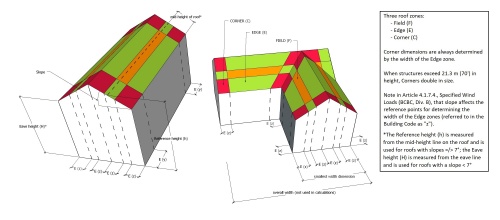
- A roof area that is divided into smaller segments by means of control joints (roof dividers, i.e., a fire wall) or expansion joints, shall be considered one roof area for the purpose of calculating the Specified Wind Loads, unless the height of a control joint or expansion joint exceeds 1 m (39"), in which case the Specified Wind Loads for each roof segment shall be calculated separately (See Figure 3.1.3.-B).
- When a building is designed with multiple roof levels (at different elevations), and the roofs are adjacent each other (having a common wall), the Specified Wind Loads for each level, and for each roof area on that level, shall be calculated separately from loads for the adjacent level, unless the elevation difference between adjacent roof levels is less than 1.524 m (5’) (Ref. Figure 3.1.3.-B).
- When the shape of a single-level roof varies in width or length, the smallest width dimensions shall be used in the calculation of Specified Wind Loads (Ref. “minimum effective width” as defined in the "British Columbia Building Code", Division B, Part 4, Article 4.1.7.2., "Classification of Buildings").
Figure 3.1.3.-B (Click to expand) 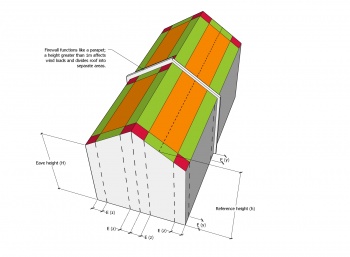
- When a roof area intersects the corner of a wall, the Edge zone on either side of the wall corner must be treated as a roof Corner (2 x C) (Figure 3.2.).
- When an existing roof system is specified for partial replacement, the Design Authority must
- calculate the Specified Wind Loads for the roof,
- determine if securement of the remaining roof components (left in situ) is sufficient to resist the Specified Wind Loads,
- determine a suitable method of securement or have the system of securement engineered, and
- calculate and design securement for any structures or equipment.
- Roof systems should be designed in conjunction with the electrical systems for the building, to avoid unnecessary interference with roof system securement (See also Subsection 2.1.8., "Electrical Cables and Boxes").
- Mansards are a roof system and are therefore subject to the requirements in this Part.
- Securement of an adjoining waterproofing system shall be made in accordance with the requirements in the applicable Standard.
3.1.3.3. Resistance to Specified Wind Loads
- The wind uplift resistance capabilities of the selected roof system must equal or exceed the Specified Wind Loads calculated for each roof zone to which the system will be applied (see Article 3.1.3.2.).
- Engineered designs to resist wind uplift may refer to the "British Columbia Building Code", Div. B, Appendix C, "Table C-2", which lists various types of loads, including wind loads, for specific reference locations throughout the province.
3.1.3.4. Resistance to Other Loads
- In addition to its capacity to resist Specified Wind Loads, the roof system must be capable of resisting or accommodating
- all anticipated live and dead loads, including (without limitation) other environmental loads, such as rain and snow, expected for the building’s size and location,
- gravity ("drag") loads,
- loads from overburden (See Part 14), and
- thermal expansion and contraction of the roof system components.
3.1.3.5. Reserved
3.1.4. Reserved
3.1.5. Reserved
3.1.6. Reserved
3.1.7. Roof Replacement and Alterations
3.1.7.1. Complete Roof System Replacement
- Complete roof system replacement projects must be designed to secure the new roof system against displacement by Specified Wind Loads and must follow the design requirements specified by the Design Authority.
Section 3.2. Materials
3.2.1. Reserved
3.2.2. Securement Materials
3.2.2.1. Fasteners
- The Design Authority should specify the correct type of fastener, keeping in mind
- pull-out strength, and
- corrosion resistance (contributing factors to fastener corrosion may include dissimilar metal contact, excessive building humidity, corrosive chemicals within components of the roof system, or corrosive elements provided within the building envelope etc.).
- Fasteners must be capable of securing the roof system components to resist Specified Wind Loads.
- Fasteners
- used to secure asphalt shingles shall conform to the requirements in Article 9.2.1.4., and
- used to secure linear metal flashings shall conform to the requirements in Article 13.2.1.3.
Section 3.3. Application
3.3.1. Guarantee Term Requirements
3.3.1.1. RoofStar 5-year and RoofStar 10-year Guarantee
- To qualify for a RoofStar 5-year or RoofStar 10-year Guarantee, all projects shall comply with the requirements in this Part.
3.3.2. All Systems
3.3.2.1. Securing Systems with Mechanical Fasteners
(See Figure 3.2.2-A and Figure 3.2.2.-B)
- Mechanically fastened underlayments must be installed with fasteners approved by the product manufacturer.
- All asphalt shingles must be secured with nails
- conforming to the requirements in Article 9.2.1.4., and
- installed through the common bond, conforming to CSA-A123.51, "Asphalt shingle application on roof slopes 1:6 and steeper".
- Where high nailing is required by the manufacturer in certain circumstances, minimum securement must nevertheless be through the common bond (see minimum nailing requirements in this Part).
- Nails installed on the edges of the common bond, and nail heads that are exposed to the weather, are considered non-conforming to this Standard.
- Driven nails
- must penetrate the deck at least 19.05 mm (3/4”) when measured from the top face of the deck, and
- shall be perpendicular to the shingle and deck surface.
- Nails must not be under-driven, over-driven, or crookedly driven.
- On Low Slopes and Common Slopes (up to 1:1 (12" in 12")), at least four (4) nails for each full shingle shall be used.
- On Steep Slopes (1:1 (12" in 12") up to and including 21:12), at least 6 nails for each full shingle shall be used.
- Notwithstanding any nailing patterns specifically accepted by the RoofStar Guarantee Program, shingles installed on Extreme Slopes (slopes greater than 21:12) shall be
- fastened with at least 6 nails per full shingle, consisting of 1 nail at each end of the shingle and double nails at each third point.
- manually cemented in place underneath each tab, immediately after installation, using a spot of asphalt plastic cement approximately 22 mm (7/8") in diameter that is located at the centre of each shingle tab (This may be exceeded by manufacturer’s requirements).
- When partial shingles (segments), ridge or hip caps are installed, each shall be fastened
- with at least two (2) nails set in from either edge by 25.4 mm (1”).
- with nails set no more than
- 330.2 mm (13”) apart, when installed on slopes up to and including 1:1 (12" in 12").
- 203.2 mm (8”) apart when installed on slopes greater than 1:1 (12" in 12").
- Unless superseded by the threaded fastener manufacturer’s published requirements, threaded mechanical fasteners must penetrate
- steel decks at least 19.05 mm (3/4") – fasteners should penetrate the top flutes only,
- into solid dimensional lumber by at least 25.4 mm (1"), or
- through plywood sheathing by at least 19.05 mm (3/4”).
3.3.3. Reserved
3.3.4. Reserved
3.3.5. Reserved
3.3.6. Roof Replacement and Alterations
3.3.6.1. Complete Roof System Replacement
- Roof systems that are removed and replaced in their entirety (excluding the air or vapour controls, which may be left in place at the discretion of the Design Authority) must be secured following the requirements for new roof systems.
3.3.6.2. Partial Roof Replacement
- When only a portion of an existing roof system is specified for replacement, the new materials must be secured to resist wind Specified Wind Loads, following the design specified by the Design Authority (See also Subsection 1.1.4., "Replacement and Alterations").
Part 4 - Materials
Section 4.1. Design
4.1.1. General
4.1.1.1. Scope
- The scope of this Part and the Standard shall be as described in Division A, Part 1.
4.1.1.2. Definitions
- Words that appear in italics are defined in the Glossary. Additionally, the following terms are used in this Part:
- Primary Material means a material used in a roof or grade-level waterproofing system that protects a building interior from water. Primary materials are often exposed to the weather (protected membranes are an exception), and therefore also protect secondary materials from damage. Membranes, metal panels, asphalt shingles, and cedar shakes and shingles, form the core body of materials classified as primary.
- Secondary Material means one which forms part of a waterproofing system or water-shedding system, and which may affect the wind resistance characteristics of the entire assembly but is not necessarily exposed to the weather.
4.1.2. Reserved
4.1.3. Reserved
Section 4.2. Materials
4.2.1. Material Properties
4.2.1.1. Use of Accepted Materials
(For limitations and exclusions pertaining to materials, see Division A, Article 3.2.1.2.)
- All materials installed by the Contractor, for new construction or alterations, must be
- newly manufactured (except for reusable insulation; see Article 7.1.3.2.), and may not be recycled without the expressed, written consent of the Guarantor,
- accepted by the RoofStar Guarantee Program, and
- manufactured by, or listed as acceptable to, the manufacturer of the primary material.
- All uninstalled materials must be
- protected from weather with wrappers approved or recommended by the manufacturer,
- properly stacked, and
- secured above ground or on the roof surface.
- All installed roofing materials that are susceptible to moisture damage must be made watertight by the end of each workday.
- Metals and fasteners must be compatible with each other, to avoid galvanic corrosion which can occur when dissimilar metals contact each other.
Section 4.3. Application
4.3.1. Guarantee Term Requirements
3.3.1.1. RoofStar 5-year and RoofStar 10-year Guarantee
- To qualify for a RoofStar 5-year or RoofStar 10-year Guarantee, all projects shall comply with the requirements in this Part.
4.3.2. All Systems
4.3.2.1. Application of New Materials
- All new materials installed as part of the roof system shall conform to the manufacturer's published requirements, unless stated otherwise in this Standard.
Part 5 - Deck and Wall Overlays
Section 5.1. Design
5.1.1. General
5.1.1.1. Scope
- The scope of this Part and the Standard shall be as described in Division A, Part 1.
5.1.1.2. Definitions
- Words that appear in italics are defined in the Glossary.
5.1.2. Guarantee Term Requirements
5.1.2.1. RoofStar 5-year and RoofStar 10-year Guarantee
- To qualify for a RoofStar 5-year or RoofStar 10-year Guarantee, all projects shall comply with the requirements in this Part.
5.1.3. All Systems
5.1.3.1. Required Use of Overlays
(See Note A-5.1.3.1.)
- A deck or wall overlay must be specified when the conditions of the deck or wall are unsuitable for receiving roofing materials.
- Steel decks require a plywood deck overlay
- to support the underlayment, and
- with sufficient thickness to permit fastening of asphalt shingles..
Section 5.2. Materials
(See Division C, "Accepted Materials")
5.2.1. Material Properties
5.2.1.1. Suitability of Overlays
- Deck and wall overlays must be
- listed in Division C,
- acceptable to the manufacturer,
- suitable for the type of deck, and
- suitable for, and compatible with, any membrane or panel application.
- When plywood is used as a deck overlay, only tongue-and-groove plywood is acceptable and must be
- at least 12.7 mm (1/2”) thick when installed over a mass timber deck, or
- at least 15.88 mm (5/8”) thick, when the roof supports overburden.
5.2.1.2. Reserved
5.2.1.3. Overlays for Walls
- In addition to overlays listed in Division C, walls may be overlaid with
- plywood, provided the plywood is least 12.7 mm (1/2”) thick and is pressure-treated when applied over concrete or concrete masonry units (CMU), or
- fibre-mat reinforced cement boards with a minimum thickness of 9.53 mm (3/8"), conforming to ASTM C1325 (latest edition), "Standard Specification for Fiber-Mat Reinforced Cementitious Backer Units".
5.2.1.4. Fasteners
- Refer to Article 3.2.2.1.
Section 5.3. Application
(This Section shall be read in conjunction with the requirements for substrate preparation in Part 9 and Part 10)
5.3.1. Guarantee Term Requirements
5.3.1.1. RoofStar 5-year and RoofStar 10-year Guarantee
- To qualify for a RoofStar 5-year or RoofStar 10-year Guarantee, all projects shall comply with the requirements in this Part.
5.3.2. All Systems
5.3.2.1. Support, Arrangement, and Securement of Deck Overlays
- Deck overlays must be
- fully or intermittently supported along all edges by the deck, and
- installed in a staggered pattern (offset) 304.8 mm (12") from adjacent board rows (a minus offset tolerance of 50.8 mm (2") maximum will be permitted to compensate for variance in the manufacturer's tolerance of differing board widths and lengths).
- Deck overlays shall be affixed to the deck with
- mechanical fasteners conforming to the requirements in Article 3.2.2.1.,
- polyurethane foam adhesives acceptable to the manufacturer and conforming to the requirements in Article 3.2.2.2., or
- a combination of mechanical fasteners and polyurethane foam adhesives.
- When mechanical fasteners are used to secure deck overlays, the minimum number of fasteners (in combination with plates) shall be four (4), for every 1219.2 mm x 2438.4 mm (48" x 96") sheet.
5.3.2.2. Overlays on Steel Decks
- Steel decks must be overlaid with plywood conforming to the requirements in Article 2.1.5.4., and shall be of sufficient thickness to permit nailing of asphalt shingles as required in Article 3.3.2.1.
5.3.2.3. Reserved
5.3.2.4. Overlays on Wood Decks
- A mechanically fastened overlay board is required for any deck structure that does not meet the deck fastening criteria set out in Article 2.1.5.3..
5.3.2.5. Support, Arrangement, and Securement of Wall Overlays
- Wall overlay panels must be
- mechanically fastened with screw fasteners spaced no more than 304.8 mm (12”) O.C., both vertically and horizontally; fasteners must align with structural supports, and shall be placed
- at the perimeters,
- at the corners, and
- in the field, or
- adhered with a polyurethane adhesive, applied with a continuous z-patterned ribbon spaced no less than 304.8 mm (12”) apart.
- mechanically fastened with screw fasteners spaced no more than 304.8 mm (12”) O.C., both vertically and horizontally; fasteners must align with structural supports, and shall be placed
Part 6 - Air and Vapour Controls
(See Note A-6)
Section 6.1. Design
6.1.1 General
6.1.1.1. Scope
(See Note A-6.1.1.1.)
- The scope of this Part and the Standard shall be as described in Division A, Part 1.
6.1.1.2. Definitions
- Words that appear in italics are defined in the Glossary. Additionally, the following terms are used in this Part:
- Air barrier means a material that is manufactured and tested to prohibit the passage of air through that material.
- Continuity means a sealed, resistive, continuous connection
- between control layers that have the same function, and
- between a control layer and another material or object it joins to (i.e., a roof drain or penetration).
- Control layer means a material used in a roof assembly or wall assembly, that is manufactured and tested to resist or control the movement of air, vapour, or liquid water into or through that assembly.
- Vapour retarder means a material that is manufactured and tested to prohibit or regulate the passage of water vapour through that material.
- Water resistive barrier (WRB) means a material that is manufactured and tested to resist the transmission of liquid water through the material, and is usually used in wall assemblies.
6.1.2. Guarantee Term Requirements
6.1.2.1. RoofStar 5-year and RoofStar 10-year Guarantee
- To qualify for a RoofStar 5-year or RoofStar 10-year Guarantee, all projects shall comply with the requirements in this Part.
6.1.3. All Systems
6.1.3.1. Responsibility for Design
- The Design Authority is responsible to specify
- air and vapour control materials,
- the placement of continuous air and vapour control layers in relation to a roof system and its components, and
- the selection of suitable materials for that application (See Note A-6.1.3.1.).
- The Design Authority is urged to review and consider the performance characteristics of materials available for such applications.
- Coverage under the RoofStar Guarantee shall be as described in Division A, Article 3.2.1.2..
- Notwithstanding coverage provisions in Division A, neither the RoofStar Guarantee Program nor the Contractor will accept any responsibility for damage to, or failure of, the roof system caused by the use or absence of air or vapour control layers.
6.1.3.2. Continuity of Control Layers
- The Design Authority, and trades constructing walls and roofs, are jointly responsible for making proper connections (continuity) between air and vapour control systems, including the transitions between wall systems and roof systems.
- Where air, vapour, or water control layers intersect a roof drain, overflow drain, scupper drain, or penetration, the intersection must be designed for continuity, and drawings must detail the execution of continuity for the Contractor.
- Overflow drains and scupper drains that penetrate wall assemblies must be designed and drawn to prevent air intrusion from the outside environment (Ref. Article 3.1.5.1.).
6.1.3.3. Use of Air Control Materials
- The Design Authority is responsible for the selection of air control materials (some air control layers are considered vapour permeable, others vapour-impermeable); roof systems intended to qualify for a RoofStar Guarantee should be designed according to the regulatory design and installation requirements for effective, continuous air control systems.
- All materials selected by the Design Authority should conform to the material and performance characteristics required in the "British Columbia Building Code", Division B, Article 5.4.1.2., "Air Barrier System Properties".
6.1.3.4. Use of Vapour Control Materials
- Because continuous vapour control layers may be needed to limit “water vapour transmission and condensation, burn protection, and severe climatic conditions” (National Energy Code of Canada for Buildings 2020, Article 5.2.5.3.(1), "Other Considerations"; see also the "British Columbia Building Code", Division B, Article 5.5.1.1., "Required Resistance to Vapour Diffusion"), they are considered discretionary and must be specified by the Design Authority.
- Where continuous vapour control layers are required and specified by Code, the RoofStar Guarantee Program requires that a suitable vapour control system be selected by the Design Authority and properly installed by the Contractor in conformity with the vapour control layer manufacturer’s published instructions, and with the Design Authority’s specified details.
6.1.3.5. High-humidity Building Interiors
- Careful consideration should be given to the performance characteristics of air and vapour control layers when specifying such a membrane for roof systems constructed over high-humidity building interiors, which may be susceptible to the accumulation of moisture within the roof system unless effective air and vapour controls are installed; these building interiors include (but are not limited to)
- swimming pools,
- commercial laundry facilities,
- large aquariums, and
- paper mills.
6.1.3.6. Reserved
Section 6.2. Materials
6.2.1. Material Properties
6.2.1.1. Compatibility with Other Materials
- The material selected for air and vapour control layers must be compatible with any other materials in the roof or wall assembly to which the control layer may come in contact, including (without limitation) contact with primers and adhesives, substrates, solvents, and cleaners.
6.2.1.2. Permitted Materials for RoofStar Guarantee
(See Note A-6.2.1.2.)
- While responsibility for the selection of suitable air and vapour control layers rests with the Design Authority, a roof designed and built to qualify for a RoofStar Guarantee shall not include
- polyethylene sheet plastic, or
- bitumen-impregnated kraft paper.
6.2.1.3. Puncture Resistance and Thickness
- Air and vapour controls should be installed over a continuous smooth plane, regardless of a material's ability to span voids or spaces in the deck.
- Fully supported air and vapour control layers should possess a minimum published static puncture resistance rating of 150 N (34 lbf) (Ref. CGSB-37.56-M for both test method and standard limits) and be either self-adhering or torch-applied; a high puncture resistance is necessary for the membrane to withstand accidental damage during construction.
- Where no deck overlay board is installed and the air and vapour control layers are partially unsupported (for example, on a steel deck), the control layers must possess a published static puncture resistance of at least 400 N (90 lbf).
- Should the air or vapour control layers be used as a temporary roof during project construction by either the Contractor or by other trades, a minimum 2 mm thick bituminous membrane is recommended.
6.2.1.4. Self-adhered and Torch-applied Materials
- Self-adhering or adhesive-applied materials should be considered as alternatives to torch-applied membranes when the substrate to which they will be applied is combustible, or when nearby structures, openings or materials present a fire hazard.
- A suitable separation or overlay material may be used as protection from open flame is acceptable; the application of materials to a combustible surface, using a torch, is strictly prohibited.
6.2.1.5. Vapour Controls for Concrete Decks
- Because curing concrete releases considerable moisture that can compromise the performance of a roof system, a vapour control layer installed on new concrete decks (28 days or older) must be selected to prevent condensation inside the roof system.
- A membrane with a permeability of 0.01 perms (Class I) is recommended for applications on concrete substrates, but the selection of vapour control materials is nevertheless the responsibility of the Design Authority.
Section 6.3. Application
6.3.1. Guarantee Term Requirements
6.3.1.1. RoofStar 5-year and RoofStar 10-year Guarantee
- To qualify for a RoofStar 5-year or RoofStar 10-year Guarantee, all projects shall comply with the requirements in this Part.
6.3.2. All Systems
6.3.2.1. Continuity and Support
- The Contractor must
- ensure that air and vapour control layers in the roof system field, and at perimeters, are installed to provide at least 101.6 mm (4”) of overlap, for continuity of matching layers in adjacent assemblies,
- ensure that air and vapour control layers are sealed to penetrations and drains that pass through or enter the roof assembly, and
- seal all control layers to matching layers in adjacent assemblies (i.e., walls), when a roof is replaced.
- Installation of all air and vapour control materials must be smooth and uniform, without wrinkles or fish-mouths, and must also conform to the manufacturer’s published requirements and the Design Authority’s design details.
- All air and vapour control membrane side and end laps must be fully supported, in the field and at transitions with curbs, parapets, walls, and penetrations.
- When self-adhered membranes are applied directly to a steel supporting deck,
- membranes should be oriented parallel to the direction of deck flutes, and
- membrane laps and changes in plane must be supported by deck flutes, or by flat metal supports secured to the deck to span gaps.
- When metal supports are used to span gaps between steel deck flutes, they must be
- fabricated from pre-finished steel with a thickness no less than 24-gauge, and
- secured to the deck with no fewer than two (2) compatible screw fasteners per flute (See Figure 6.3.2.-A and Figure 6.3.2.-B).
6.3.2.2. Torch-applied Materials
- The application of materials to an unprotected combustible material, using a torch, is strictly prohibited.
- All combustible materials MUST be protected from open flame by an acceptable separation or overlay material; this includes, without limitation, combustible materials
- on decks, walls, blocking, and canted edges, and
- that are hidden or obscured within voids, cracks, or orifices.
- When a torch-applied membrane is specified over combustible materials, all joints between overlay panels, and at roof-wall transitions, must be sealed with the primary membrane manufacturer’s approved self-adhered membrane or tapes.
- Where torch-applied membranes are not permitted or desirable, the installation of bituminous air and vapour control layers should align with the approaches described and required in the "Standard for SBS-modified Bitumen Membrane Roof Systems", Subsection 10.3.8., "Alternative Approaches to Sheet Membrane Flashing".
6.3.2.3. Securement on Slopes
- Self-adhered membranes applied to slopes greater than 1:6 (2” in 12”) should be additionally secured with mechanical fasteners in locations where slippage may occur, to counter-act material displacement resulting from temperatures that exceed the membrane’s service temperature.
6.3.2.4. Reserved
Part 7 - Insulation
Section 7.1. Design
7.1.1. General
7.1.1.1. Scope
- The scope of this Part and the Standard shall be as described in Division A, Part 1.
7.1.1.2. Definitions
- Words that appear in italics are defined in the Glossary. Additionally, the following terms are used in this Part:
7.1.2. Guarantee Term Requirements
7.1.2.1. RoofStar 5-year and RoofStar 10-year Guarantee
- To qualify for a RoofStar 5-year or RoofStar 10-year Guarantee, all projects shall comply with the requirements in this Part.
7.1.3. All Systems
7.1.3.1. Reserved
7.1.3.2. General Requirements
(See Note A-7.1.3.2.)
- Board and batt insulation is not used directly with asphalt shingle roof systems, but may be used below the roof deck, provided a ventilation space no less than 63.5 mm (2-1/2"), measured between the underside of the roof deck and the top face of insulation, is retained beneath the deck to keep it cool (Ref. the "British Columbia Building Code", Division B, Part 9, Article 9.19.1.1., "Required venting", and Article 9.19.1.3., "Clearances").
- Spray foam insulation may not be used directly beneath a roof deck that supports an asphalt shingles roof system, unless the manufacturer, and the Guarantor, jointly agree in writing that
- the longevity and performance of the asphalt shingles will not be compromised (i.e., a material warranty and the RoofStar Guarantee will be issued without qualification or exclusions), and
- moisture in the roof deck can be adequately vented out of the roof assembly.
Section 7.2. Reserved
Section 7.3. Reserved
Part 8 - Eave, Valley, and Field Underlayment
Section 8.1. Design
8.1.1. General
8.1.1.1. Scope
- The scope of this Part and the Standard shall be as described in Division A, Part 1.
8.1.1.2. Definitions
- Words that appear in italics are defined in the Glossary. Additionally, the following terms are used in this Part:
- Eave and Valley Protection means a self-adhering sheet membrane applied in valleys and in parallel courses on the roof deck along the eaves, up the roof slope to a point measured vertically from the inside of the exterior wall, and intended to block the ingress of water that may leak behind shingles or metal roof panels as the result of snow or ice buildup on the roof surface.
- Underlayment means a sheet (rolled) material that is either self-adhering or mechanically fastened (typically with large head nails), and which is installed
- immediately over the supporting deck or deck overlay,
- to provide secondary protection between the water-shedding system materials and the building interior, and
- to keep water-shedding system materials from adhering to the deck..
8.1.2. Guarantee Term Requirements
8.1.2.1. RoofStar 5-year and RoofStar 10-year Guarantee
- To qualify for a RoofStar 5-year or RoofStar 10-year Guarantee, all projects shall comply with the requirements in this Part.
8.1.3. All Systems
8.1.3.1. Eave Protection
- Sheet membrane eave protection is required on all Common Slope, Steep Slope, and Extreme Slope roofs, but is not required
- over unheated spaces, and
- where the roof overhang exceeds 914.4 mm (36") measured along the roof slope from the edge of the roof to the inner face of the exterior wall.
- Sheet membrane eave protection
- must conform to the material requirements in Article 8.2.1.2.,
- must be installed on the supporting deck or on a deck overlay,
- may also serve as an air barrier or vapour retarder, or as both, when installed in combination with an underlayment sharing the same performance characteristics,
- must be at least 1 mm thick when the roof slope exceeds 1:3 (4” in 12”),
- shall be at least 1.4 mm thick when the roof slope is less than 1:3, and
- must be carried
- a minimum of 304.8 mm (12") up inside interior walls (609.6 mm (24") in heavy snow load conditions), and
- down the vertical face of the eave and rake edges by at least 25.4 mm (1").
8.1.3.2. Valley Protection
- Valley Protection is required on all projects, shall conform to the requirements for eave protection in Article 8.1.3.1., and shall be specified to cover the entire valley, even where eave protection is exempt.
8.1.3.3. Field Underlayment
- The underlayment below shingles, regardless of its type, serves as the final water barrier above the roof deck and is required on all Asphalt Shingle Roof Systems.
- Underlayments
- must be self-adhering when the roof slope is less than 1:3 (4" in 12"), or
- may be nail-applied or self-adhered when the roof slope is greater than 1:3 (4" in 12").
- Self-adhered membranes specified for slopes less than 1:3 (4" in 12")) must
- conform to the material requirements in Article 8.2.1.3., and
- achieve a finished thickness of at least 1.4 mm (nominal).
- Multiple layers of self-adhering eave protection membrane may be specified to achieve the minimum thickness requirement in this Article, but
- each layer must be at least 1.0 mm thick,
- layering must be permitted by the Guarantor through a written Variance (Ref. Article 1.1.3.6.)
8.1.3.4. Separation Between Materials
- In all applications, a non-adhering roof field underlayment may be specified as a separation layer over any self-adhering membrane, to separate the shingles from the membrane and thus prohibit bonding of the two, which can simplify future shingle replacement (it spares the supporting deck from damage during tear-off).
Section 8.2. Materials
(See Division C, "Accepted Materials")
8.2.1. Material Properties
8.2.1.1. Suitability of Materials
- All membranes must be supplied with proprietary sealants, mastics, tapes, and primers, each one suitable for the application of the underlayment.
8.2.1.2. Eave and Valley Protection
- Sheet membranes used for eave and valley protection must
- conform to the requirements in CSA-A123.22, "Self-adhering polymer modified bituminous sheet materials used as steep roofing underlayment for ice dam protection,"
- be made of bitumen with a high softening point and a minimum flow temperature of 87.7°C (190°F) when they are used immediately below any metal panels or flashing (Ref. ASTM D5147, "Standard Test Methods for Sampling and Testing Modified Bituminous Sheet Material"),
- shall be self-adhering, and
- must have a sanded or synthetic, non-bonding top surface.
8.2.1.3. Underlayment
- Mechanically attached polymeric ("synthetic") fabric underlayments shall conform to the criteria in RGC ACWS-PUL, "RGC Acceptance Criteria for Mechanically Attached Polymeric Roof Underlayments Used in Water-shedding Systems".
- Modified bituminous sheet membrane underlayments must conform to the requirements in Article 8.2.1.2.
- Non-perforated mechanically attached asphalt saturated felt roof underlayments shall conform to CSA A123.3, "Asphalt saturated organic felt roofing" and / or ASTM D226/D226-M.
8.2.1.4. Reserved
8.2.1.5. Reserved
8.2.1.6. Fasteners
- Mechanical fasteners used to secure nail-applied underlayments must conform to the underlayment manufacturer’s requirements.
- Staples are not permitted.
Section 8.3. Application
8.3.1. Guarantee Term Requirements
8.3.1.1. RoofStar 5-year and RoofStar 10-year Guarantee
- To qualify for a RoofStar 5-year or RoofStar 10-year Guarantee, all projects shall comply with the requirements in this Part.
8.3.2. All Systems
8.3.2.1. Installation of Eave Protection
- Where eave protection is required, it must
- overhang the fascia by at least 25.4 mm (1”),
- extend up the slope at least 914.4 mm (36"), or to a line not less than 304.8 mm (12") inside the inner face of the exterior wall (609.6 mm (24") in regions with heavy snow; see Figure 8.3.2.-A), and
- extend up all abutments (walls, skylights, etc.) at least 152.4 mm (6″) above the surface of the finished roof system surface.
- Horizontal runs of eave protection must be positively lapped at least 50.8 mm (2″) and end laps (vertical joints) must be at least 152.4 mm (6″).
8.3.2.2. Valley Protection
- Valley protection sheet membranes shall
- be the same materials used for eave protection, conforming to the requirements in Article 8.2.1.2.,
- be centred on, and installed parallel to, the valley line, extending from the eave edge past the upper end of the valley metal flashing, at least 50.8 mm (2”),
- be at least 1000 mm (approx. 39”) wide, or wide enough to extend past the outside edges of a metal valley flashing onto each roof field by at least 152.4 mm (6”),
- positively overlap lower runs of valley membrane by no less than 152.4 mm (6”), rolled to ensure even, full adhesion, and
- overlap and be sealed to the the sheet membrane installed at the eaves ("eave protection").
8.3.2.3. Underlayment for Common and Steep Slopes
- All nail-applied polymeric ("synthetic") and felt underlayments installed on Common Slope and Steep Slope roofs
- shall be installed using fasteners acceptable to the manufacturer of the underlayment,
- shall be secured to conform to the underlayment manufacturer's published instructions,
- must run parallel to the eave,
- shall positively overlap adjacent material by
- at least 76.2 mm (3″) along the sides, unless exceeded by the manufacturer’s instructions, and
- at least 152.4 mm (6″) at the ends, unless exceeded by the manufacturer’s instructions,
- must run beneath all water-shedding system materials, irrespective of slope,
- must extend beneath all perimeter linear metal flashing,
- shall cover the roof deck beneath all penetration flashings, and
- must be carried up vertical surfaces at least 152.4 mm (6”) above the roof deck, where roofing materials and flashings adjoin walls or curbs.
- "Negative" laps that are unavoidable in horizontally applied courses of underlayment are permissible, but only when
- the underlayment is a self-adhering membrane (Ref. Article 8.2.1.3.),
- the membrane runs overlap at least 152.4 mm (6"), and
- lapped seams are roller-pressed and sealed with a compatible sealant along the seam edge.
- Only self-adhered bituminous or butyl underlayments may be installed perpendicular to the eave, but this shall be only when permitted by the manufacturer, and
- laps must be at least 152.4 mm (6"),
- seams must be roller-pressed and sealed with a compatible sealant along the seam edge,
- membrane must extend to the edge (break) of the metal eave or rake flashing, and
- positively laps beneath other vertical membranes.
- Organic felt underlays shall be relaxed before they are installed.
- To prevent shingles from bonding to self-adhering membranes, and simplify future roof replacement, a non-bonding underlayment may be used as a separation layer between the shingles and the membrane.
8.3.2.4. Underlayment for Slopes Less Than 1:3
- All roofs sloped less than 1:3 (4" in 12") must be covered with one or more layers of self-adhered underlayment membrane,
- conforming to the material requirements in Article 8.2.1.3.,
- achieving a finished thickness of at least 1.4 mm (nominal), and
- installed to conform to to the requirements in Article 8.3.2.4.
- Applying multiple layers of self-adhering eave protection membrane to achieve the minimum thickness requirement is permissible, provided
- layering is acceptable to the underlayment manufacturer,
- the second layer is offset from the first by at least 304.8 mm (12"), both horizontally and vertically, and
- the Design Authority has obtained a written Variance from the Guarantor permitting multiple layers.
8.3.2.5. Reserved
8.3.2.6. Reserved
Part 9 - Roof Field (Shingle Systems)
Section 9.1. Design
9.1.1. General
9.1.1.1. Scope
- The scope of this Part and the Standard shall be as described in Division A, Part 1.
9.1.1.2. Definitions
- Words that appear in italics are defined in the Glossary. Additionally, the following terms are used in this Part:
- Manufacturer means the manufacturer of the primary roof covering, unless stated otherwise.
- Parallel to Slope means the direction parallel to the angle of a sloped plane.
9.1.2. Guarantee Term Requirements
9.1.2.1. RoofStar 5-year and RoofStar 10-year Guarantee
- To qualify for a RoofStar 5-year or RoofStar 10-year Guarantee, all projects shall comply with the requirements in this Part.
9.1.3. All Systems
9.1.3.1. General Requirements
- All projects shall be designed to conform to the requirements in Section 9.3. of this Standard, and shall conform to CSA-A123.51, "Asphalt shingle application on roof slopes 1:6 and steeper", unless superseded by the requirements in this Standard.
- The roof design must incorporate methods for managing the flow of water from one roof surface to another, to protect the weathering surface of shingles from undue wear and tear.
9.1.3.2. System Securement
- Shingle securement must be designed to resist Specified Wind Loads (Ref. Article 3.1.3.2. and Article 3.1.3.3.), and shall specify the appropriate fasteners for the application.
Section 9.2. Materials
(See Division C, "Accepted Materials")
9.2.1. Material Properties
9.2.1.1. Reserved
9.2.1.2. Shingles Acceptable for RoofStar Guarantee
- All asphalt shingles shall be manufactured in compliance with RGC ACWS-ASH, "RGC Acceptance Criteria for Inorganic Glass-Reinforced Asphalt Shingles Used in Water-shedding Assemblies".
- Shingles specified for slopes less than 1:3 (4" in 12") shall be expressly manufactured for that application, or shall be permitted for the application in the published instructions for the shingle.
- Starter shingles or rolls must be acceptable to the field shingle manufacturer.
9.2.1.3. Reserved
9.2.1.4.Fasteners
(See also Article 3.2.2.1.)
- Nails (gunnable or hand-driven) for field and hip and ridge shingles must be
- manufactured in conformity to CSA B111, "Wire Nails, Spikes and Staples."
- corrosion resistant (hot-dipped or stainless steel).
- at least 2 mm (12 Ga.) thick in the shank, with large 9.53 mm (3/8”) heads.
- of sufficient length to penetrate through, or at least 19.05 mm (3/4”) into, the roof deck (sheathing).
- Staples may not be used to secure asphalt shingles.
- Cladding Screws must be
- No. 8 (1/8") gauge or larger.
- fitted with a rubber gasket.
- compatible with, and corresponding in colour to, metal flashing material.
9.2.1.5. Reserved
9.2.1.6. Reserved
9.2.1.7. Sealants
- Sealants shall be
- non-hardening high quality butyl or polyurethane,
- available in either gun grade or sealant tape form,
- suitable for exterior use and able to resist the effects of weathering, and
- compatible with, and able to adhere to, the materials to which they are applied.
- Sealants shall conform to any one of the following standards:
- CGSB 19-GP-5M, "Sealing Compound, One Component, Acrylic Base, Solvent Curing"
- CAN/CGSB-19.13, "Sealing Compound, One Component, Elastomeric, Chemical Curing"
- CGSB 19-GP-14M, "Sealing Compound, One Component, Butyl-Polyisobutylene Polymer Base, Solvent Curing"
- CAN/CGSB-19.24, "Multi-Component, Chemical Curing Sealing Compound"
9.2.2. Materials Storage and Handling
9.2.2.1. Protection from the Weather
- All uninstalled materials must be protected from weather by properly stacking them above ground, or above the roof surface, in or beneath covers that are weather-resistant and secured against displacement by wind (See also Article 4.2.1.1., "Use of Accepted Materials").
- Shingles shall be kept inside the manufacturer’s packaging until the time of application and must be free of damage or contamination on the sealing strips.
9.2.3. Accessories
9.2.3.1. Accessories Supplied by Asphalt Shingle Manufacturer
- All asphalt shingle accessory components must be supplied by and acceptable to the manufacturer.
Section 9.3. Application
9.3.1. Guarantee Term Requirements
9.3.1.1. RoofStar 5-year and RoofStar 10-year Guarantee
- To qualify for a RoofStar 5-year or RoofStar 10-year Guarantee, all projects shall comply with the requirements in this Part.
9.3.1.2. Reserved
9.3.2. All Systems
9.3.2.1. Preparation of Substrate
- All supporting decks must be acceptable to the manufacturer and must be
- made suitable for roofing by others (trades other than the Contractor),
- dimensionally stable,
- structurally sound,
- capable of accommodating roof system component movement,
- clean,
- adequately dry and frost-free (Ref. Subsection 2.1.5., "Roof Decks"),
- reasonably smooth and free of abrupt elevation changes, and
- absolutely free of
- dust,
- dirt,
- voids,
- open cracks,
- sharp projections,
- contaminants,
- objectionable surface treatments,
- oil, and
- grease
- Plywood decks with cracks or loose knots must be filled or overlaid with plywood (See Article 5.2.1.1.).
- Joints between plywood deck panels must be prepared and reinforced according to the manufacturer’s published requirements.
- If surface drying is required prior to roofing, the deck must be dried with blown air.
9.3.2.2. Preparation of Roofing Materials
- Roofing materials must be prepared and for installation, as required by the manufacturer.
- Self-adhesive strips must be clean and free of any material that could inhibit bonding with underlying shingles.
9.3.2.3. Reserved
9.3.2.4. General Requirements for Asphalt Shingle Application
- All materials must be installed in overlapping layers that positively shed water to a lower surface; asphalt shingles must be installed to provide double coverage.
- Materials must be secured in accordance with various Parts in this Standard.
- Water must be allowed to flow freely off the roof.
- Nails must never be exposed to water.
- Asphalt shingles shall be installed to comply with CSA-A123.51, "Asphalt shingle application on roof slopes 1:6 and steeper", unless superseded by requirements in this Standard.
- A starter course or strip-type shingle is required at the eaves and rake (gable) edges, below the first course of shingles and must be installed
- flush with the edges of the underlayment,
- onto the valley metal and membrane flashings, and
- with no fewer than four (4) nails (Ref. Article 3.3.2.1.).
- Each course of shingles following the first course shall be installed so that
- all vertical and horizontal lines running true, or follow a random pattern as directed by the manufacturer’s printed instructions,
- shingles extend beyond the eave and rake flashing at least 12.7 mm (1/2"), to support the shingles and lead water into eaves troughs, and
- exposure and nailing patterns conform to the manufacturer’s printed product-specific instructions.
- Each succeeding course of shingles must offset according to the manufacturer’s published instructions, but in any event shall not be less than 127 mm (5”).
- The minimum offset requirements above do not apply to
- shingle segments applied to cover rafter tails, which must be centred on the rafter tail and overlap its edges by at least 12.7 mm (1/2”), or to
- shingle segments installed around penetration flashings and vents, or adjacent to valleys, which must not be less than 203.2 mm (8”) in width.
- So-called “Dutch laps” are not permitted.
- When shingles are installed in cooler temperatures (typically below 10° C), shingles must be
- hand-sealed with a shingle cement/adhesive acceptable to the shingle manufacturer, and
- fastened with additional nails, as specified by the manufacturer.
- When the underlayment is organic felt, the underlayment and asphalt shingles must be installed on the same day.
- When roofing work is complete, the Contractor must remove all temporary fall protection fittings and equipment.
- If permanent fall protection anchor points are desirable, they must be specifically required and allocated by the Design Authority and incorporated into the roof design.
9.3.2.5. Application on Slopes Less Than 1:3
- In addition to the general requirements in Article 9.3.2.4., shingles installed on slopes less than 1:3 (4" in 12") must conform to the specific application requirements published by the manufacturer for low slope installations.
9.3.2.6. Reserved
9.3.2.7. Changes in Slope
(See Figure 9.3.1.-A and Figure 9.3.1.-B)
- When the field roof slope changes more than 1:6 (2” in 12”),
- underlayment for the lower roof area must be carried across the transition, onto the upper roof deck, at least 203.2 mm (8”) and in any event must extend past the top edge of the metal transition flashing by at least 50.8 mm (2”),
- the upper-most course of shingles on the lower roof must terminate at the slope transition line,
- a metal transition flashing must be installed at the change in plane and must be
- broken (bent) to bridge the transition, and to exert pressure on the lower slope shingles,
- installed over the lower courses of underlayment,
- secured to the upper slope with mechanical fasteners set in from the edge of the flashing 25.4 mm (1”) and spaced no more than 304.8 mm (12”) O.C. (a hidden cleat used to secure the lower edge of the metal flashing is recommended but not required - see the illustrations below), and
- lapped over the shingles on the lower slope at least 101.6 mm (4”).
- When the angle between slopes is less than 180° (i.e., the lower roof plane slope is less than the slope of the upper roof plane), a self-adhering membrane strip is required to overlap the upper edge of the metal flashing by at least 50.8 mm (2”); the membrane must extend up-slope at least 50.8 mm (2”) past the bottom layer of underlayment and be sealed to the roof deck.
- Shingles installed on the slope above the change in plane must be started and installed as a new application and shall conform to the requirements in Article 9.3.2.4.
Part 10 - Perimeters and Walls
Section 10.1. Design
10.1.1. General
10.1.1.1. Scope
- The scope of this Part and the Standard shall be as described in Division A, Part 1.
10.1.1.2. Definitions
- Words that appear in italics are defined in the Glossary.
10.1.2. Guarantee Term Requirements
10.1.2.1. RoofStar 5-year and RoofStar 10-year Guarantee
- To qualify for a RoofStar 5-year or RoofStar 10-year Guarantee, all projects shall comply with the requirements in this Part.
10.1.3. All Systems
10.1.3.1. General Requirements
- The Design Authority is responsible to specify the connections between the roof system and walls or other building components, particularly where the continuity of air, vapour and water-resistive layers is critical or required by Code (See Part 6, "Air and Vapour Controls").
- Projects must follow proper sequencing; materials must positively integrate (“shingle fashion”) with other materials, systems, or assemblies, including those installed by other trades.
- Wall surfaces must be suitable to receive roof materials, or they must be covered with an accepted overlay panel material listed in Division C.
- Where the roof deck and an adjoining wall are constructed of dissimilar materials (i.e., steel deck joined to concrete wall), differing expansion and contraction rates for the two materials may adversely affect the roof system and, in particular, the field and flashing membranes, and therefore it is incumbent upon the Design Authority to consult the manufacturer's literature and specify the correct materials for each particular roof-wall intersection (See Note A-10.1.3.1. ).
- When EIFS cladding is cut to permit roofing work, the exposed insulation must be restored with back-wrapped mesh, a base coat and finish coat, or with another method that is equal or superior (See Note A-10.1.2.2).
- Fascia may be covered with metal flashing and specified as part of the roof system.
10.1.3.2. Flashing
- All changes in plane in the roof system, and all intersections between the roof field and roof edges, walls, or parapets, must be flashed with self-adhering sheet membrane eave protection, and with metal flashing.
- Linear metal flashing is required at all roof edges, ridges, hip perimeters, and at the tops of parapets, to protect sheet membrane flashing from damage.
10.1.4. Perimeter Details, Walls, and Openings
(The requirements in Subsection 10.1.3., "All Systems", shall be read together with the following Articles)
10.1.4.1. Ridges
- Ridge design shall conform to the application requirements in Article 10.3.4.1.
- Ridge venting may be specified, and shall conform to the requirements in Article 12.2.1.4., "Air Vents", and Article 12.3.2.5..
10.1.4.2. Eave and Rake Edges
- Eave and rake edge details shall be designed to resist wind uplift loads, and shall conform to the requirements in Article 10.3.4.2.
- Linear metal flashing must be specified for all eave and rake (gable) edges.
- A diverter flashing is not mandatory at the bottom of a rake edge (gable end), but is recommended to direct water away from barge rafters and exposed fascia tails, and to direct water into gutters.
10.1.4.3. Walls
- Step flashings must be specified to flash roof transitions with walls, parapets or curbs ranging from 90° to 120°, when measured on the face of the slope from the eave edge.
- All step flashings must be new.
- Cloning step flashings is not permitted.
- A back-pan flashing must be specified when a wall, parapet or curb intersects the roof plane at 120° or more, measured on the face of the slope from the eave edge.
- A head-wall flashing must be used only at the top of a sloped roof, where a wall, parapet or curb intersects the roof perpendicular to the slope or at an angle to the slope not exceeding 45° down, and must be inserted behind the wall finish and extending over the top course of shingles at least 101.6 mm (4”) (See also Article 10.3.4.2.).
- When a wall at the top of a slope changes plane at the corner, the corner must be flashed with a head-wall flashing fashioned to turn up the slope.
- A diverter flashing must be used at the bottom end of a wall that intersects a roof parallel to the slope.
10.1.4.4. Reserved
10.1.4.5. Windows and Wall Openings
- Windows and other wall openings adjacent an Asphalt Shingle Roof Systems shall conform to the relevant requirements in the "Standard for SBS-modified Bitumen Membrane Roof Systems", Article 10.1.4.5..
10.1.5. Valleys
10.1.5.1. Valley Protection Membrane
- Valley protection membrane shall conform to the requirements in Article 8.1.3.1. and Article 8.1.3.2.
10.1.5.2. Valley Flashing
- All valleys must be designed with both membrane flashing and metal valley flashing.
- Metal valley flashing must be used for laminate, interlocking, and Low Slope shingle applications, and in any event are recommended for all roof designs.
- Where a Steep Slope roof plane drains onto a Common Slope or Low Slope roof, the valley metal flashing must be fashioned with double inverted “V” dividers (See Figure 13.2.2.-D).
10.1.5.3. Valleys for Heavy Snow Loads
- In regions with high snow loads, the minimum valley width should be increased and flared to widen at the eave (See Article 1.1.3.2., "Snow Loads", and Article 10.1.5.1.).
10.1.5.4. Reserved
10.1.5.5. Dead Valleys
- Dead valleys should be avoided, but when a roof slope terminates in a dead valley, it must be designed as a waterproofing roof system the design must conform to the Application requirements in Article 10.3.5.7.
10.1.6. Expansion and Control Joints
(The requirements in Subsection 10.1.3., "All Systems", shall be read together with the following Articles)
10.1.6.1. Reserved
10.1.6.2. Control Joints (Roof Dividers)
- The Design Authority is responsible
- to determine the need for control joints (roof dividers), and
- to specify their location and design.
- Unless otherwise approved by the Guarantor, control joints must be specified to divide a new roof system (addition) from existing roof systems (Ref. Article 1.1.4.5.).
10.1.7. Intersections with Other Roof Systems
10.1.7.1. Intersections with Waterproofing Roof Systems
- Intersections with water-shedding roofs must be designed according to the requirements in Article 10.3.7.2.
10.1.7.2. Intersections with Membrane Gutters
- Refer to Article 11.1.4.3.
Section 10.2. Materials
(See Division C, "Accepted Materials")
10.2.1. Material Properties
10.2.1.1. Flashing Membrane
- See Article 8.2.1.2. for sheet membrane requirements.
10.2.1.2. Linear Metal Flashing
- Linear metal flashing incorporated into roof perimeters and walls must conform to the materials and fabrication requirements in Part 13, "Linear Metal Flashing".
10.2.1.3. Asphalt Shingle Accessories
- Starter shingles or rolls must be acceptable to the field shingle manufacturer.
- Caps used on hips and ridges must be acceptable to the field asphalt shingle manufacturer and be of the same material as the shingles.
10.2.1.4. Sealants
- Sealants applied to linear metal flashing, where sheet membrane flashing is terminated, shall conform to the requirements in Article 13.2.1.4.
10.2.2. Securement Materials
10.2.2.1. Fasteners
- Fasteners used to secure starter strips shall be the same as those used to secure asphalt shingles, and shall therefore conform to the requirements in Article 3.2.2.1.
- Ridge cap fasteners must be at least 44.45 mm (1-3/4”) long but must nevertheless be long enough to penetrate the roof deck by at least 19.05 mm (3/4”).
- All fasteners must be compatible with the materials they will contact, including all metal flashings.
- Mechanical fasteners used to secure linear metal flashing shall conform to the requirements in Article 13.2.1.3.
Section 10.3. Application
10.3.1. Guarantee Term Requirements
10.3.1.1. RoofStar 5-year and RoofStar 10-year Guarantee
- To qualify for a RoofStar 5-year or RoofStar 10-year Guarantee, all projects shall comply with the requirements in this Part.
10.3.2. All Systems
10.3.2.1. Preparation of Substrate
10.3.2.1. Substrate Preparation
- All wall surfaces to which roofing materials must be installed (including Concrete Masonry Unit (CMU)) must be declared suitable by the manufacturer, or they must be covered with a RoofStar-accepted overlay panel conforming to the material requirements in Article 5.2.1.3. and installed to conform to Article 5.3.2.5.
10.3.2.2. Preparation of Roofing Materials
10.3.2.2. Material Preparation
- Membrane flashing shall be prepared following the manufacturer's published requirements.
10.3.2.3. General Application Requirements for Perimeters and Walls
- Every transition in plane must be flashed (under-laid) with a non-adhering underlayment or a self-adhering eave protection sheet membrane acceptable to the Guarantor; the choice is slope-dependent and at the discretion of the Design Authority, but in any event is subject to the requirements in Part 8, "Eave, Valley, and Field Underlayment".
- All materials must be installed in overlapping layers that positively shed water to a lower surface; asphalt shingles must be installed to provide double coverage.
- Materials must be secured in accordance with various Parts in this Standard.
- Water must be allowed to flow freely off the roof.
- Nails must never be exposed to water.
- Projects must follow proper sequencing so that materials, systems, or assemblies, installed by the Contractor correctly interface with materials, systems, or assemblies installed by other trades, to establish or preserve continuity and ensure positive waterproofing connections (overlapping, “shingle fashion”).
- When coordination with other trades requires some adaptation to the requirements in this Standard, any variance to proper detail sequencing must be approved in writing by the Design Authority.
- All sheet membrane flashing must be installed to conform to the manufacturer's published instructions, and must
- be fully bonded to an acceptable substrate,
- be installed without fish-mouths or wrinkles,
- be hand-rolled with a manufacturer’s accepted roller and fully bonded to an acceptable, prepared substrate,
- be reinforced at all inside and outside corners with membrane gussets, measuring at least 101.6 mm x 152.4 mm (4” x 6”), excluding the tapered ends,
- overlap any wall membranes or finishes by at least 50.8 mm (2”), and
- underlap any wall membranes or finishes by at least 76.2 mm (3").
- The upper termination of sheet membrane flashing must be protected from damage, and from water intrusion,
- with linear metal flashing installed in keeping with Article 13.3.3.1., or
- with a wall finish installed by others.
- All step flashings must be new.
- Cloning step flashings is not permitted.
- Linear metal flashings must be secured in keeping with the requirements in Article 13.3.2.1.
10.3.2.4. Protection of Membranes
- Membrane flashing must be protected from damage with full-coverage linear metal flashing.
10.3.3. Reserved
10.3.4. Perimeter Details, Walls, and Openings
(The requirements in Subsection 10.3.2., "All Systems", shall be read together with the following Articles)
10.3.4.1. Ridges and Hip Caps
- Ridge and hip caps must be
- installed according to the manufacturer’s published instructions, or to these Standards, whichever are greater,
- applied to provide a minimum double coverage, including the first cap,
- secured in keeping with Article 3.3.2.1., and
- free of exposed nails, except for the last cap (an acceptable sealant must be applied to seal exposed nails; see Article 10.2.1.4.).
10.3.4.2. Eaves and Rake Edges
- Linear metal flashing must be installed at all eave and rake (gable) edges.
- Eave and rake edge metal flashing
- must be installed above a separation layer and below the eave protection layer,
- must extend at least 12.7 mm (1/2”) past the edge of the supporting deck, to accommodate gutter hangars (for existing or specified gutters), and
- must be secured with acceptable nails driven through the flashing leg into the roof deck no more than 406.4 mm (16”) O.C.
- Sheet membrane eave protection or metal flashing underlayment must overhang eave fascia at least 25.4 mm (1”), to direct water into gutters.
- All types of shingles installed on common slope and steep slope roofs
- must be installed with a starter course along the eaves, and
- must overhang the fascia approximately 38.1 mm (1-1/2”), or with sufficient overhang to lead water into exposed eaves trough (Extend the overhang further for low slope roofs).
- At eave and rake edges (and in valleys), underlayment may be carried all the way to the roof edge, covering the self-adhered protection membrane, to keep shingles from bonding to the membrane.
- Asphalt shingles must be installed so that they overlap a rake (gable) edge by at least 12.7 mm (1/2”), unless exceeded by the manufacturer’s published requirements.
- Shingles installed on low slopes must be sealed in a bed of compatible mastic at all rake edges.
- When rafter tails or barge rafters extend past the eave edge and are flush with the roof deck, they should be protected with
- shingles, or
- a metal cap flashing that is
- fabricated with drip edges along all three sides and a flange extending onto the roof deck, and
- secured with at least two (2) fasteners.
- Fascia flashing, when specified as part of the roofing work, must be fastened on the vertical face no more than 609.6 mm (24”) O.C. in a staggered pattern, and fasteners shall be placed at least 25.4 mm (1”) from top edge of the fascia.
- When the fascia board extends above the surface of the finished roof system surface,
- the fascia board must be covered on the top and inside faces with eave protection membrane (to separate metal from wood),
- step flashing, trimmed to match the height of the fascia, must be used as required in this Article for roof-to-wall intersections, and
- cap flashing used to cover the top surface of the fascia board must be joined and secured in keeping with the Article 13.3.2.1.
10.3.4.3. Walls
- Step flashing shall
- extend at least 127 mm (5") up vertical surfaces,
- be installed behind wall control layers (i.e., water-resistive barrier) or a counter-flashing (where used),
- extend at least 101.6 mm (4") horizontally between courses of roofing,
- have a 76.2 mm (3") head-lap above the shingle exposure,
- be placed flush with the butt edge (bottom) of each asphalt shingle course, and
- be fastened with nails located 50.8 mm (2") down from the top edge and 25.4 mm (1") in from the outside edge on the deck flange portion of each step flashing.
- Where step flashing is used, a drainage path of no less than 6.35 mm (1/4”) and no more than 12.7 mm (1/2”) must be provided between the edge of the shingle and the vertical face of the step flashing.
- Head-wall and apron flashing must be
- installed behind wall control layers,
- extend at least 101.6 mm (4”) over roofing material,
- secured to the wall with nails set no closer than 304.8 mm (12”) O. C. (new construction), and
- secured through the shingles into the supporting roof deck, with cladding screws
- spaced every 609.6 mm (24"), and
- located at least 25.4 mm (1”) in from the safety edge of the flashing.
- Lengths of head-wall or apron flashing may be overlapped rather than seamed; each overlap must be at least 101.6 mm (4”) when fully caulked in the lap, or 152.4 mm (6”) when installed without caulking in the lap.
- Head-wall and apron flashing must be combined with an inside corner step flashing where a shingled slope intersects with an overhanging soffit.
- A diverter flashing, to direct water into gutters,
- must be installed under the first course of shingles at the junction of roof eaves and a wall and must be installed over roof material by at least 101.6 mm (4"), and
- may be installed at the lower end of a rake edge under the second course of shingles.
10.3.4.4. Reserved
10.3.4.5. Windows and Wall Openings
- Windows and other wall openings that intersect with the roof system shall be flashed with membrane and metal conforming to the requirements in Article 10.3.4.5. of the "Standard for SBS-modified Bitumen Membrane Roof Systems", .
10.3.5. Valleys
(The requirements in Subsection 10.3.2., "All Systems", shall be read together with the following Articles)
10.3.5.1. Valley Protection
- Valleys must be protected with a self-adhered sheet membrane conforming to the requirements in Article 8.2.1.2. and installed to conform to Article 8.3.2.2.
10.3.5.2. General Requirements for Valley Metal Flashing
- Valley metal flashing
- must be installed before any shingle application (the installation of shingle starter strips beneath the metal valley flashings is not acceptable),
- shall be installed without joints or fasteners where eave protection membrane is installed, but where shorter lengths are unavoidable a membrane connection must be made between the two lengths of valley flashing,
- shall be secured to the deck,
- must extend
- to the edge of the eaves, and
- to the upper end of the valley or, where a slope continues above it, beyond the valley to a point no less than 304.8 mm (12”) past the termination of the valley, and
- shall positively overlap adjoining lengths of flashing (shingle-style).
- Valley metal flashing shall be secured
- with cleats nailed to the roof deck no more than 457.2 mm (18”) O.C. and hooked onto the outside edges of the flashing, or
- through the metal flashing, with nails conforming to Article 3.2.2.1. and spaced
- no more than 457.2 mm (18”) O.C., and
- approximately 25.4 mm (1”) in from the edge of the metal flashing,
- Where lengths of valley flashing overlap, each overlap must be at least
- 203.2 mm (8”) when fully caulked in the lap, or
- 304.8 mm (12”) when installed without caulking in the lap.
- A single central upstanding diverter/divider is required for valley metal flashing, but may be omitted when the valley is less than 1219.2 mm (48”) long.
- Two evenly spaced upstand diverters/dividers are required where a steep slope roof drains onto a common slope or low slope roof (See Article 13.2.2.1.).
- Valley metal flashing installed on low slope roofs, or in regions with high snow accumulation, shall be continuously sealed to the valley protection membrane along the edges of the flashing using 152.4 mm (6”) wide lengths of the same sheet membrane, centred along each edge of the metal flashing.
10.3.5.3. Open Valleys
- Open valleys are the only style permitted for
- lock-type shingles,
- laminated asphalt shingles, and
- all shingle applications on a low slope roof.
- Open valleys
- for any slope may be constructed with a sheet metal valley flashing, or
- with one layer of granule-faced SBS-modified bituminous membrane (for common slope and steep slope roofs only)
- measuring at least 3.7 mm thick and 1 m (39") wide,
- centred in the valley, and
- fastened with nails spaced not more than 457.2 mm (18"), located approximately 25.4 mm (1") away from the membrane edges.
- All shingles terminating at the valley must be
- cut so that space between the cut edges of opposite roof faces widens toward the eave,
- trimmed diagonally at upper corners on the head lap,
- secured no closer than 152.4 mm (6") from the valley centreline,
- no less than 203.2 mm (8”) in width (See Article 9.3.2.4.), and
- sealed in a bed of compatible mastic (low slope applications only).
10.3.5.4. California Valleys
- "California" valleys (a variation on open valleys) are permissible for laminated shingles, subject to approval by the manufacturer, and must be constructed in keeping with the requirements in this Article, or the manufacturer’s published installation requirements, whichever are greater.
- Laminated shingles used as a valley starter must be
- laid end to end vertically up each side of the installed metal valley flashing, so that their bottom edges align with and are set back from the centre of the valley by at least 50.8 mm (2”) (use a chalk lines for guidance), and
- nailed through the common bond using at least four (4) fasteners per shingle (Ref. Article 3.3.2.1.).
- Laminated field shingles (uncut) must be
- laid perpendicular to the roof slope and overlap the valley starter shingles installed on either side of the valley centre line,
- secured no closer than 152.4 mm (6") from the butt edge of valley starter shingles,
- completely cover the butt-end joints of valley starter shingles,
- no less than 203.2 mm (8”) in width, and
- installed in keeping with the general requirements in Article 9.3.2.4.
10.3.5.5. Woven Valleys
- Woven valleys must be constructed only with single-layer three-tab shingles and are not acceptable for laminated shingles.
- Shingles must be installed in alternating courses, first on one side of the valley and then on the other, repeating this pattern so that the shingle from each course that lies across the valley overlaps the other, creating a "woven" pattern.
- Shingles that extend across the valley
- must overlap the roof plane on the other side of the valley at least 304.8 mm (12"), and
- must be secured
- on either side of the valley, but no closer than 152.4 mm (6") from the valley centre line, and
- on the opposite side of the valley, both through the common bond and at the upper corner of the shingle.
10.3.5.6. Closed (Cut) Valleys
- Closed-cut valley may be used only on roof slopes exceeding 1:3 (4" in 12"), and only if permitted in writing by the manufacturer.
- Closed-cut valleys shall not be used with laminated asphalt shingles.
- Shingles must be pressed tightly into the valley.
- No nails may be fastened within 152.4 mm (6”) of the valley center-line.
- Two nails must be used to secure the ends of the shingles in the valley; fasten the overlapping shingles both at the end of the common bond, and at the upper corner of the shingle.
10.3.5.7. Dead Valleys
- Dead valleys must be
- waterproofed to conform to the requirements for membrane gutters (See Article 11.3.3.8.), and
- sloped at least 1:50 (2%, or 1/4” in 12”), to positively drain
- into one or more roof drains, or
- onto a lower water-shedding roof.
- Transitions from a dead valley to asphalt shingles must conform to the requirements in Article 10.3.7.2., and where a wall is present, a diverter shall be incorporated to protect the wall system..
10.3.5.8. Valley Changes in Slope
- When a valley with metal flashing changes slope, direction, or both (the "transition"),
- valley membrane protection must be continuous, carried across the transition,
- each valley (on either side of the transition) must be flashed with a separate metal valley flashing,
- metal valley flashing must overlap at the transition by at least 203.2 mm (8"),
- the transition between metal valley flashing must be bridged with a flexible membrane flap (i.e., 1.524 mm (60 mil) semi-cured EPDM), or with an alternative acceptable to the Guarantor, and
- the membrane flap must extend at least 101.6 mm (4") on either side of the transition,
- adhered to the lower valley metal flashing, and
- loosely tucked beneath the upper flashing.
- Where the minimum overlap for metal valley flashing is not achievable, the size of the flexible membrane flap must be increased to achieve an overall overlap of 203.2 mm (8”).
10.3.5.9. Valley Intersection with Ridge
(See Figure 10.3.5.9., A through D; also see Construction Detail "Valley Intersection with Ridge")
- Where a ridge and valleys of one roof intersect another shingled roof plane,
- valley protection membrane and metal valley flashing must be carried at least 304.8 mm (12”) past the upper termination of the valley,
- the intersection of the ridge and the other roof plane must be flashed with
- a self-ahdering lower patch, which covers the peaked joint between valley metal flashing and extends up the slope at least 152.4 mm (6”) (The width of the patch must not exceed the exposure of the ridge cap shingles), and
- an upper patch, which overlaps the lower patch by at least 50.8 mm (2”) and extends up the slope at least 152.4 mm (6”) past the metal, and
- ridge cap shingles and the continuing courses of shingles on the main roof slope must be installed using a split ridge cap shingle transition.
10.3.6. Reserved
10.3.7. Intersections with Other Roof Systems
(The requirements in Subsection 10.3.2., "All Systems", shall be read together with the following Articles)
10.3.7.1. Compatibility of Materials
- Where two roof systems intersect, materials must be compatible with each other, or must be separated from contact by an intermediate separation layer.
10.3.7.2. Intersections with Waterproofing Roof Systems
(See illustrations 10.3.7.-A and 10.3.7.-B)
- When a waterproofing roof system transitions down a slope onto a lower water-shedding roof system, the waterproofing roof system membrane must lap over the water-shedding roof system by no less than 50.8 mm (2").
- When a waterproofing roof system transitions up a slope and underlaps a water-shedding roof system,
- sheet membrane flashing must extend up the water-shedding roof system slope at least
- 152.4 mm (6”), plus 76.2 mm (3”) for the overlap by the water-shedding roof system, when measured vertically from the maximum water level,
- 203.2 mm (8”), plus 76.2 mm (3”) for the overlap by the water-shedding roof system, when measured vertically from the drainage plane, and
- 304.8 mm (12”) plus 76.2 mm (3”) for the overlap by the water-shedding roof system, when measured vertically from the drainage plane or maximum water level, in regions with typical heavy snow,
- the termination of the waterproofing roof system sheet membrane flashing on the slope must be mechanically secured, separately from the water-shedding roof system,
- underlayment must overlap the waterproofing roof system sheet membrane flashing by no less than 101.6 mm (4”),
- shingles must overlap the waterproofing roof system sheet membrane flashing by at least 152.4 mm (6”), and shall be started with a starter course,
- the bottom edge of the lowest course of shingles must be no closer to the finished roof system surface of the waterproofing roof system than 101.6 mm (4”), and
- fasteners for the water-shedding roof system must be at least 203.2 mm (8”) above the finished roof system surface of the waterproofing roof system (when measured vertically), or 304.8 mm (12”) for regions with heavy snow.
- sheet membrane flashing must extend up the water-shedding roof system slope at least
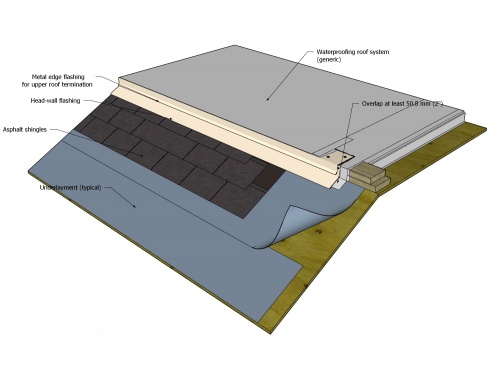
|
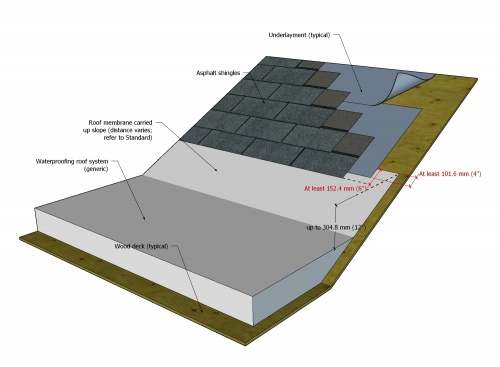
|
10.3.7.3. Intersections with Membrane Gutters
- Refer to the requirements in Article 11.3.3.8.
10.3.8. Reserved
Part 11 - Drainage
Section 11.1. Design
11.1.1. General
11.1.1.1. Scope
- The scope of this Part and the Standard shall be as described in Division A, Part 1.
11.1.1.2. Definitions
- Words that appear in italics are defined in the Glossary. Additionally, the following terms are used in this Part:
- Drain leader means "a pipe that is installed to carry storm water from a roof to a storm building drain or sewer or other place of disposal” ("British Columbia Plumbing Code", Division A, Article 1.4.1.2., "Defined Terms").
- Flanged insert drain means a primary roof drain
- with a flat, broad flange that encircles, and is manufactured from the same material as, the drain opening or bowl,
- that is spun or hot-welded (not cast),
- that typically is secured to the roof assembly with screw-type mechanical fasteners, and
- that is manufactured with a short length of drain pipe ("drain stem"), which is inserted into a drain leader and sealed against back-flow using a compression seal.
- Overflow drain ("overflow") means a secondary roof drain
- that serves as a safeguard when roof drains fail, and
- which may be located in the roof field (for example, as a secondary drain) or at the perimeter of the roof.
- Primary roof drain means the primary means of draining water from the roof.
- Roof drain means “A fitting or device that is installed in the roof to permit storm water to discharge into a leader.” ("British Columbia Plumbing Code", Division A, Article 1.4.1.2., "Defined Terms").
- Scupper drain ("Scupper") means an open or closed roof drain that conveys water laterally from one roof area to another, or from the roof directly to the exterior of the building.
- Secondary roof drain means a drain connected to a separate drainage system, typically situated at a higher elevation than a primary roof drain. An overflow drain is a type of secondary roof drain.
11.1.2. Guarantee Term Requirements
11.1.2.1. RoofStar 5-year and RoofStar 10-year Guarantee
- All projects intended to qualify for a RoofStar 5-year or RoofStar 10-year Guarantee shall comply with the requirements in this Part.
11.1.3. All Systems
11.1.3.1. Principles of Design
- The Design Authority is responsible for the design of roof drainage.
- The size (flow rate) of roof drains and overflows must be determined using the "British Columbia Building Code" and "British Columbia Plumbing Code", with attention given to both average and large rainfall events (for rainfall capacities, refer to the "British Columbia Building Code", Div. B, Appendix C, "Table C-2", which lists rainfall loads using specific reference locations throughout the province.
- Membrane gutters must be designed for their anticipated capacity, with consideration given to
- rainfall and snow load calculations for the building location,
- drain type, size, flow rate, and
- size and placement of the overflow drain.
- The Design Authority should coordinate the various disciplines (including, without limitation, mechanical (plumbing) and structural engineers) to calculate proper flow rates, head pressure, and structural supports, in anticipation of significant, short-duration rain events; consideration should be given to various design elements (listed without limitation)
- roof slope (more slope theoretically increases drainage and lessens live loading from rainfall) (Ref. Article 2.1.3.1., "General Requirements for Roof Slope"),
- rainfall rates for primary and overflow drainage,
- primary and overflow drain capacities,
- hydraulic head (pressure), and
- the location of the drainage plane (the drainage plane is not necessarily the same as the finished roof system surface, and the location of the drainage plane may affect the determination of live loads, which should be accounted for as part of drainage design).
- Roofs may drain off a roof edge, or by means of internal plumbing (both are permissible under the RoofStar Guarantee Program).
- When a roof is designed to drain off an edge, water may drain freely, it may be diverted to a lower roof area, or it may be collected and diverted into a drainage system (plumbing) by means of an external or built-in gutter (See Article 11.1.4.3.).
- The membrane of the lower roof onto which drain water is directed must be protected from abrasion with splash pads.
- When a roof is fully or partially replaced, all flanged drains, scuppers, and overflows, together with internal drain-to-pipe compression seals, and seals exposed to water or ultraviolet light, must be replaced.
- If a flow restrictor is present in an existing cast drain leader, the restrictor should be reinstalled.
11.1.3.2. Roof Drain Function and Location
- Roof drains must be used only for draining water.
- Roof drains on new construction projects must be located at least 304.8 mm (12”) away from any adjacent drain, penetration, upstand, edge, or wall (the separation space is measured between openings, excluding the flange), but this requirement does not apply to overflow drains, scupper drains, and membrane gutters (Ref. Article 11.3.3.7. for minimum requirements applicable to scuppers and overflows).
- When existing roof drain and penetration locations do not comply with the spacing requirements in this Part, the Design Authority must submit a written request for a Variance, following the requirements in Article 1.1.3.6., "Variances".
11.1.4. Drains and Membrane Gutters
(The requirements for Subsection 11.1.3.,"All Systems", shall be read together with the following Articles)
11.1.4.1. Cast-iron Roof Drains
- Only cast-iron roof drains, and existing external couplers used to connect drains to leaders, may be re-used for roof replacement projects.
- Drain extensions for cast-iron roof drains should be avoided, since the connection with the cast drain is not sealed; the result is a leak into the roof system.
11.1.4.2. Scuppers and Overflows
(See Note A-11.1.4.2.)
- A scupper drain may serve either as a primary roof drain or as a secondary drain.
- Where no overflows are specified, the building structure should be designed to carry the total load of water collected on the roof, in the event of primary roof drain failure.
- Overflow drains are required for membrane gutters, and when they are specified, they must be
- located no higher than 101.6 mm (4”) above the drainage plane,
- situated so that they freely and visibly discharge storm water, and
- specified to conform to the spacing and capacities required by the "National Plumbing Code of Canada", Division B, Article 2.4.10.4. (See also Article 11.1.3.1., "Principles of Design").
11.1.4.3. Membrane Gutters
(See Note A-11.1.4.3.)
- A RoofStar Guarantee may cover a membrane gutter (gutters lined with an adhered membrane and typically integrated into the roof structure) only when the membrane gutter and the adjoining roof area are part of the same scope of work.
- The Design Authority is responsible to design the membrane gutter for its anticipated capacity, with consideration given to
- rainfall and snow load calculations for the building location,
- drain type, size, and flow rate, and
- size and placement of the overflow drain.
- New membrane gutters shall be designed with a minimum width of 304.8 mm (12”) and a depth not exceeding the gutter’s width.
- At least 101.6 mm (4") clearance on the horizontal plane is required between any membrane gutter wall and the
- the edge of the drain bowl for spun drains, and
- the edge of the drain leader for flat spun or welded drains.
- Only fully-adhered membranes may be used in membrane gutters.
- Metal gutter liners are permissible, provided they are designed to fit over acceptable waterproofing, and the liners conform to the material requirements in Article 11.2.1.3.
- Conventionally insulated systems that drain into a membrane gutter must abut solid blocking at the gutter edge, which provides
- a stop for the insulation assembly, and
- a solid substrate for the securement of flashings and membranes.
- An overflow drain must be located at least
- 101.6 mm (4”) above the primary membrane gutter drain, and
- 25.4 mm (1”) below any mechanical fasteners used to secure the adjoining roof system.
- In roof replacement applications, existing membrane gutters may qualify for a RoofStar Guarantee, but should be redesigned if their capacity is undersized, and must incorporate an overflow drain in keeping with the requirements in this Part.
- Where the primary drain in an existing membrane gutter is undersized for its capacity, the primary drain must be replaced with one that is properly sized.
- When a membrane gutter adjoins a RoofStar-guaranteed water-shedding system, the transition from gutter to roof system shall conform to Article 11.3.3.8.
11.1.4.4. External Gutters
- External gutters and downspouts are not covered by the RoofStar Guarantee.
- Notwithstanding other requirements in this Part, when a roof drains onto another roof, the drainage of water must be controlled to eliminate or mitigate damage from water flow; the use of splash pads, when appropriate for the location, is strongly recommended.
- Downspouts, installed by the Contractor or other trades and laid directly against the slope of the roof to connect an upper roof drainage to lower gutters, is acceptable under the RoofStar Guarantee Program, provided the material is strongly secured both at the top and the bottom, and the issue of dissimilar metal corrosion can be eliminated.
Section 11.2. Materials
(See Division C, "Accepted Materials")
11.2.1. Material Properties
11.2.1.1. General Requirements
- Except for cast-iron roof drains, which are usually supplied and installed by others, only new drains and penetration flashings listed in Division C may be used.
- Reuse of any penetration flashing or drain (except serviceable cast iron drains) is prohibited and may void the Guarantee (See Division A, Article 3.2.1.2.).
11.2.1.2. Roof Drains and Scuppers
(See Note A-11.2.1.2.)
- All roof drains
- must be designed and manufactured for roof applications only, and shall not be floor drains, and
- shall be made so that the roof membrane can be sealed to the drain body or bowl (the membrane seal must not rely solely on a clamping ring).
- Cast-iron primary roof drains
- must be supplied with a sump receiver and under-deck clamp,
- should separate securement of the under-deck clamp and clamping ring from securement for the strainer, and
- must be installed by the trade supplying the roof drain.
- Cast-iron scupper drains must be
- supplied with a clamping strainer, and
- designed with cast, enclosed (captive) strainer bolt receivers (drains with bolts exposed on the back side of the drain body are not acceptable).
- Lead sheet flashing, when specified, must be sized to extend past the drain bowl by at least 152.4 mm (6”), and must have a weight of at least 15 kg/m2 (3 lb/ft2).
- All primary flanged insert drains (drains with a stem that inserts into a drain leader) must
- be manufactured with a hot-welded or seamless flange at least 101.6 mm (4”) wide (measured from the outer edge of the drain opening),
- be hot-welded at the joints between the bowl/flange and drain stem, and
- should incorporate a clamping ring (a clamping ring is recommended for primary flanged insert drains specified on any project, but clamping rings are required when primary flanged insert drains are specified for a RoofStar 15-year Guarantee).
- Primary flanged drains (insert drains or scuppers) that connect with plumbing inside the building (“internal” drains) must be constructed of
- copper (min. weight: 24 oz. sheet copper; min. thickness: 20-gauge, or 0.889 mm (0.035”)), or
- aluminum (min. thickness: 12-gauge, or 2.053 mm (0.08081”)).
- Primary flanged drains (insert drains or scuppers) that drain directly to the exterior of the building (“external” drains) must be constructed of
- copper (min. weight: of 16 oz.; min. thickness: 24-gauge, or 0.559 mm (0.022”)), or
- aluminum (min. thickness: 20-gauge material, or 0.812 mm (0.03196”)).
- All scupper drains (open, or closed (boxed)) must be
- manufactured with welded seams and joints,
- designed to extend past the outside face of the wall, and
- fabricated from
- copper (min. weight: 16 oz.; min. thickness: 24-gauge, or 0.559 mm (0.022”)), or
- aluminum (min. thickness: 20-gauge material, or 0.812 mm (0.03196”)).
- In addition to the general requirements for scupper drains, closed (boxed) scupper drains must also be
- fully enclosed on four sides, for through-wall applications,
- fabricated with a drip edge at the bottom outside edge of the drain to deflect overflow water away from the building, and
- fitted with an overflow opening on the outside face of the scupper,
- equal in capacity to the main drain leader opening, and
- at least 38.1 mm (1-1/2”) lower than the top surface of the scupper drain.
- Overflow drains
- must have a hot-welded or seamless flange at least 101.6 mm (4”) wide when measured from the outer edge of the drain opening, and
- may be manufactured from ferrous metals (See Section 13.2.).
11.2.1.3. Membrane Gutters and Gutter Liners
- Membrane gutter membranes shall be
- accepted by the Guarantor,
- acceptable to the manufacturer,
- compatible with the adjoining roof system, and
- manufactured for full adhesion (semi-adhesion and mechanical securement are not permissible).
- A reinforced liquid membrane systems (PMMA or PUMA) approved for field use and applied to an accepted SBS-modified base membrane is acceptable as a gutter membrane.
- A metal gutter liner
- may be fabricated from
- copper sheet material, incorporating soldered seams, or
- stainless steel, incorporating welded seams, and
- must conform to the sheet metal requirements in Article 13.2.1.2.
- may be fabricated from
11.2.1.4. Fasteners
- Mechanical fasteners used to secure the roof membrane and penetration flashings, or related accessories, must be
- properly sized in accordance with roof system securement requirements (See Part 3), and
- self-drilling purpose-made screws manufactured with deep, recessed heads.
11.2.1.5. Sealants
- Sealants must be manufactured by, or acceptable to, the manufacturer.
- Compression sealants must be formulated to provide waterproofed seals under compressive loads.
11.2.1.6. Liquid Membrane Flashing
- Only a RoofStar-accepted reinforced two-component catalyzed polymethyl methacrylate (PMMA) liquid membrane flashing system may be used on the water plane to flash roof drains, scuppers, and overflows.
Section 11.3. Application
11.3.1. Guarantee Term Requirements
11.3.1.1. RoofStar 5-year and RoofStar 10-year Guarantee
- To qualify for a RoofStar 5-year or RoofStar 10-year Guarantee, all projects shall comply with the requirements in this Part.
11.3.2. All Systems
11.3.2.1. Condition and Suitability of Roof Drains
- All clamping rings and strainers must be unbroken, properly seated, and fully secured.
11.3.2.2. Location and Spacing of Roof Drains
(See also Section 11.1., "Design")
- Roof drains for new construction projects must be located at least 304.8 mm (12”) away from any adjacent drain, penetration, upstand, edge, or wall (the separation space is measured between openings, excluding the flange).
- The 304.8 mm (12”) spacing requirement for roof drains does not apply to overflows, scupper drains, and drains used in membrane gutters.
- Roof drains and cap membrane seams must be offset from each other at least 304.8 mm (12”), measured from the edge of the drain.
11.3.2.3. Drain Protection Against Blockage
- All roof drains must be supplied and installed with a secured strainer to prevent debris from blocking the drain.
11.3.2.4. Membrane Flashing
- Drains must be flashed using the membrane specified and installed to waterproof a gutter, and shall be acceptable to the Guarantor.
- When fleece-reinforced liquid membrane systems are used to flash drains, only a RoofStar-accepted reinforced two-component catalyzed polymethyl methacrylate (PMMA) may be used on the drainage plane to flash roof drains, scuppers, and overflows.
11.3.3. Drains and Membrane Gutters
(The requirements for Subsection 11.3.2., "All Systems", shall be read together with the following Articles)
11.3.3.1. Reserved
11.3.3.2. General Requirements for Cast-iron Roof Drains
- Cast-iron roof drains must be installed by the plumbing/mechanical trade.
- When cast-iron roof drains are used, a sump receiver and under-deck clamp must be provided and installed by the trade supplying the roof drain.
- Drain extensions for cast-iron roof drains should be avoided.
- Existing flow restrictors removed during roof construction should be reinstalled.
- All cast-iron roof drains must be
- new or clean,
- unbroken (this applies to the clamping ring also), and
- flashed in accordance with the manufacturer's published instructions, or to the requirements published in this Part, whichever are greater.
- The continuity of air and vapour control layers must be maintained, where the controls are specified.
11.3.3.3. Cast-iron Drains Installed with Lead Flashing
- Cast-iron roof drains installed with lead flashing shall conform to the requirements of Article 11.3.3.3. in the Standard for the membrane used to waterproof the drain.
11.3.3.4. Cast-iron Drains Installed with Membrane Flashing
- Cast-iron roof drains installed with sheet membrane flashing shall conform to the requirements of Article 11.3.3.4. in the Standard for the membrane used to waterproof the drain.
11.3.3.5. Cast-iron Roof Drain Retrofitting (Replacement Roofing)
- Cast-iron roof drains retrofitting shall conform to the requirements of Article 11.3.3.5. in the Standard for the membrane used to waterproof the drain.
11.3.3.6. Flanged Insert-type Roof Drains
- Flange-type roof drain installation shall conform to the requirements of Article 11.3.3.6. in the Standard for the membrane used to waterproof the drain.
11.3.3.7. Scuppers and Overflows
- Scupper and overflow installation shall conform to the requirements of Article 11.3.3.7. in the Standard for the membrane used to waterproof their installation.
11.3.3.8. Membrane Gutters
- All gutter membrane construction shall conform to the requirements of Article 11.3.3.8. in the Standard for the membrane used in related waterproofing applications.
11.3.3.9. External Gutters
- When external gutters are attached to an Asphalt Shingle Roof System, they shall not interfere with the free movement of water or air away from the roof system.
Part 12 - Penetrations and Curbs
Section 12.1. Design
12.1.1. General
12.1.1.1. Scope
- The scope of this Part and the Standard shall be as described in Division A, Part 1.
12.1.1.2. Definitions
- Words that appear in italics are defined in the Glossary.
12.1.2. Guarantee Term Requirements
12.1.2.1. RoofStar 5-year and RoofStar 10-year Guarantee
- To qualify for a RoofStar 5-year or RoofStar 10-year Guarantee, all projects shall comply with the requirements in this Part.
12.1.3. All Systems
12.1.3.1. General Requirements for Penetrations
- Where a roof design includes openings through the roof assembly (i.e., for mechanical or electrical services), the specification and detail drawings shall
- provide direction for continuity of control layers, where these layers intersect with any opening or penetration, and
- require a curb or an acceptable penetration flashing to enclose and seal each roof opening.
- Each penetration (except for clustered or bundled electrical cables) must be flashed separately from others.
- Single or bundled electrical cable penetrations must be flashed with a suitable goose-neck flashing, fitted with a weather head.
- Penetration flashings must be
- new,
- suitable for the type of penetration, and
- properly sized and fitted around the penetration to permit a seal (gaps between the penetration and the inside of the flashing shall be no more than 12.7 mm (1/2"), or
- of sufficient height to be made water-tight with a site-fabricated membrane seal fashioned to enclose the gap between the flashing and the penetration (see Figure 12.3.2.1.-A); the application of liquid sealant around the penetration in an open-top flashing is not acceptable.
- Penetration flashings should be selected for their ability to inhibit the intrusion of vermin and insects into the roof assembly and building interior.
- Suitable flashings must be specified for penetrations that are expected to expand, contract, or otherwise move.
- Every flanged penetration flashing
- must be separated from the underlying substrate with underlayment conforming to the material requirements in Article 8.2.1.3. and installation requirements in Article 8.3.2.3. or in Article 8.3.2.4.,
- shall be sealed to the roof with a horseshoe-shaped patch of self-adhering sheet membrane conforming to the application requirements in Article 12.3.2.1., and
- shall underlap the upper course of underlayment.
- Cylindrical ("pipe-type") penetrations must be sealed with
- the manufacturer’s proprietary rubber-based friction seals that utilize mechanical clamps,
- a 2-part site-fabricated or proprietary flashing with a removable inspection/access cap (Ref. Construction Detail SBS 11.3.3.3-2), or
- roof curbs fitted with customized metal hoods or square-to-round metal flashing.
- Flexible boot flashings for pipe-type penetrations ("5-in-1" flashing)
- are not recommended for new construction because their waterproofing installation relies on proper execution by other trades, and
- are permitted only when installed together with a properly fitted and caulked galvanized storm collar.
12.1.3.2. Reserved
12.1.3.3. Separation Between Details
- Penetrations on new construction projects must be separated
- from the edge of metal valley flashing by at least 101.6 mm (4"), and
- from other penetrations, drains, curbs, walls, or changes in plane by at least 304.8 mm (12"), measured between openings or from the edge of a detail (but excluding the flashing flange); the exception to this requirement is customized penetration flashings designed for multiple individual or clustered penetrations.
- When a roof is replaced and existing penetration locations do not comply with the spacing requirements in this Part, the Design Authority must submit a written request for a Variance, as specified in Article 1.1.3.6.
12.1.3.4. Curbs
- The design and placement of curbs and sleepers shall be the responsibility of the Design Authority, but shall in any event conform to the application requirements in Article 12.3.2.4.
- Curbs
- must be designed for securement directly to the deck structure, or to intermediate blocking (they must not be situated on top of the roof system), and
- shall be designed to achieve a minimum height of 152.4 mm (6”), measured from the surface of the drainage plane or from the highest point of a curb cricket; proprietary deck-mounted skylights with curb profiles lower than the minimum are permissible, provided they are capable of shedding water that flows over and around the skylight structure.
- Every curb must be waterproofed to conform to Article 12.3.2.4.
- Water must be allowed to flow freely off the roof.
12.1.3.5. Attic Ventilation
- The design and selection of the ventilation system is the responsibility of the Design Authority, and may be achieved by incorporating into the roof design both intake and exhaust vents, including (without limitation),
- eave vents,
- gable end vents,
- hip vents,
- static vents,
- ridge vents, and
- cupolas.
- Attic (roof cavity) ventilation
- must meet the minimum requirements of the Code having jurisdiction, even in conditions where snow cover is present (See the "British Columbia Building Code", Division B, Article 9.19.1.3., "Clearances") (Roofs that do not provide adequate ventilation do not qualify for a RoofStar Guarantee), and
- shall be suitable for
- the slope of the roof,
- the vented area, and
- the design and configuration of the roof structure, and
- shall be provided for roofs over cathedral ceilings.
- Continuous ridge venting systems
- are acceptable and are recommended for all areas with vaulted ceilings,
- shall be used only on horizontal ridges (not on hips),
- are permissible when the primary slopes of the roof equal or exceed 1:3 (4” in 12”), and
- may be used on slopes less than 1:3, but only when permitted by manufacturer’s published installation instructions.
12.1.3.6. Railings, Ladders, and Other Attached Structures
- Railings, ladders, and other attached structures shall not be affixed to asphalt shingles and should be designed for attachment to vertical surfaces only.
Section 12.2. Materials
(See Division C, "Accepted Materials")
12.2.1. Material Properties
12.2.1.1. Membranes Used for Flashing
- Membranes used to flash (strip in) penetrations and curbs shall be rated for high temperatures and must be the same as those used for eave and valley protection (See Article 8.2.1.2.).
12.2.1.2. General Requirements for Penetration Flashings
- All roof penetration flashings, except flashings that are proprietary to the manufacturer and flashings that are installed or supplied by others as part of a Code-compliant, certified chimney assembly (i.e., for solid fuel heating appliances), must be
- accepted by or acceptable to the Guarantor,
- manufactured to conform to CSA-B272, "Prefabricated Self-Sealing Roof Vent Flashings" (a penetration flashing fabricated by the Contractor is exempt from this requirement),
- permanently marked with the standard number it conforms to, which shall be independently validated through published testing by a qualified third-party,
- manufactured from sheet metal conforming to the material requirements in Section 13.2., when the flashing is custom-made or fabricated by the Contractor,
- compatible with the roof system,
- seamless or, in the alternative, fabricated with fully hot-welded joints, including a base flange at least 101.6 mm (4”) wide,
- capable of inhibiting the intrusion of vermin and insects into the roof assembly and building interior, and
- of sufficient height to extend vertically (when measured from the up-slope base of the flashing upstand to the opening at the top) at least
- 203.2 mm (8”), for slopes 0 to 1:6 (2” in 12”),
- 152.4 mm (6”), for slopes greater than 1:6 and equal to 1:3 (4” in 12”), or
- 101.6 mm (4”), for slopes greater than 1:3.
- Metal penetration flashings that are purpose-made for
- electrical cables must be goose-necked and supplied with a downward-facing weather head, and
- plumbing vents shall be supplied with a matching settlement cap produced by the same manufacturer.
- In regions that experience high snow accumulations, penetration flashings taller than the stated minimums in this Article are strongly recommended.
- Storm collars
- must be fashioned from galvanized or stainless steel,
- must slope downward from the penetration approximately 45°,
- shall be at least 50.8 mm (2”) wide,
- shall be self-locking or, in the alternative, manufactured to receive a mechanical band clamp, and
- should be fabricated with a channel at the top edge, for retaining sealant.
- EPDM used to form a seal between a penetration and its flashing (Ref. Article 12.3.2.1.(12)) shall be semi-cured and possess a nominal thickness of no less than 60 mils.
- Unshielded flexible mechanical couplings used to join a flashing and a pipe penetration shall be
- certified to meet ASTM C564 or ASTM D5926,
- certified to meet ASTM C1173 and CSA-B602,
- supplied with top and bottom proprietary screw-type stainless steel mechanical clamps,
- leak-proof, resistant to chemicals, UV-stable, and
- suitable for the penetration and flashing they join together.
- Chimney chase caps must be
- galvanized metal conforming to the requirements in Article 13.2.1.2.,
- fabricated with penetration collars at least 152.4 mm (6") in height,
- soldered at all joints in the drainage plane, and
- fabricated with slope to shed water.
12.2.1.3. Flashings for Heating and Plumbing Systems Penetrations
- Lead plumbing vent flashings must each be
- fabricated with sheet lead material weighing no less than 14.65 Kg/m2 (3lb/sf),
- properly sized for the pipe, and
- supplied with a settlement cap made from the same materials (the inside collar of the settlement cap must fit vertically inside the pipe opening by at least 25.4 mm (1”)).
- In addition to the general requirements in Article 12.2.1.2., all metal penetration flashings (except natural airflow vents) used for heating and plumbing penetrations must be
- properly sized for the penetration, both in diameter and height,
- flexible or sloped to suit the roof slope, and
- supplied with a properly sized galvanized storm collar or settlement cap.
12.2.1.4. Air Vents
- Vents, regardless of their type, must be either
- proprietary to, or privately labeled for, the shingle manufacturer, or
- specifically accepted by the RoofStar Guarantee Program (See Article 12.2.1.2.).
- Ridge vents must be
- acceptable to the manufacturer,
- internally reinforced to provide support for shingle caps,
- suitable for slopes 1:4 and greater, and
- constructed with internal baffles to prohibit the intrusion of
- insects,
- vermin,
- snow, and
- debris.
- Natural air flow vents must be
- Type B or C ventilators conforming to CAN3-A93-M82 (R2003), "Natural Airflow Ventilator for Buildings", and permanently marked with the standard number,
- tested by an accredited third party to verify compliance with the required Standard,
- fabricated from plastic or corrosion-resistant metal (painted or unfinished), and
- manufactured with a base flange that measures
- at least 76.2 mm (3”) wide on the up-slope side of the flashing, or
- at least 50.8 mm (2”) along the vertical sides, and along the bottom side of the flashing.
Section 12.3. Application
12.3.1. Guarantee Term Requirements
12.3.1.1. RoofStar 5-year and RoofStar 10-year Guarantee
- To qualify for a RoofStar 5-year or RoofStar 10-year Guarantee, all projects shall comply with the requirements in this Part.
12.3.2. All Systems
12.3.2.1. General Requirements for Flashing Penetrations
- All penetration flashing materials must be new.
- All penetrations must be flashed to seal the penetration where it passes through the deck and underlayment, and must prevent water ingress at least 203.2 mm (8") above the finished roof system surface.
- Each roof penetration must have its own flashing (except where a purpose-made flashing is designed for multiple penetrations), and each flashing
- must be suitable for the slope and penetration, and
- must be properly sized and fitted around the penetration to permit a seal.
- All flanged vent and penetration flashings
- must be secured to the roof deck with mechanical fasteners,
- shall be sealed to the roof deck with a horseshoe patch of self-adhering membrane, and
- shall be located no closer to the ridge than 304.8 mm (12”), or two courses of shingles, whichever is greater.
- A penetration flashing that is manufactured with pre-drilled or moulded nail and screw holes shall be secured
- with nails, where fasteners will be covered by shingles, and
- with gasketed screw fasteners, when the fastener will be exposed to the weather.
- A penetration flashing that is not manufactured with pre-drilled or moulded fastening holes shall be secured
- with nails driven through the flange in the top corners of flashing flange and at the mid-point on either side of the flange, and placed no closer to the edge than 12.7 mm (1/2"), and
- with screw-type fasteners driven through the bottom flange (one fastener centred below the flashing upstand when it is 203.2 mm (8”) or less in width, or two fasteners when the flashing body is wider).
- The horseshoe patch of self-adhering membrane
- must extend up the slope at least 203.2 mm (8”) past the top of the flange,
- shall be overlapped by the next (upper) course of underlayment,
- shall extend down-slope from the opening at least 50.8 mm (2”),
- shall be hand-rolled with a roller acceptable to the membrane manufacturer,
- must overlap the side flanges of the flashing by at least 38.1 mm (1-1/2”) and beyond the flange, onto the roof surface, by at least 101.6 mm (4”), and
- must provide a drainage path
- no less than 12.7 mm (1/2”) on either side of the penetration upstand, and
- no less than 19.05 mm (3/4”) at the top of the penetration upstand.
Figure 12.3.2.-A (click on image for Construction Detail) 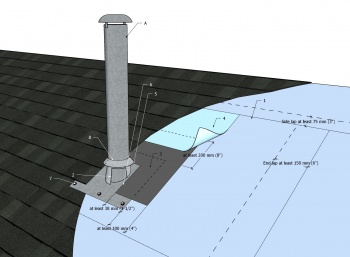
- Plastic vent flashings shall not be used
- for combustion or grease laden venting, or
- in combination with solvent-based primers, cements or mastic.
- Shingles installed around a flanged penetration flashing or curb with step flashings
- must be nailed outside the flange of a plastic vent,
- may be nailed through a metal flange,
- must be manually tabbed when the flange of a penetration flashing is wider than 101.6 mm (4”),
- shall maintain double coverage, and
- must provide a drainage path of no less than 6.35 mm (1/4”) and no more than 12.7 mm (1/2”) between the edge of the shingles and the sides of the penetration or curb.
- Cable and horizontal pipe penetrations must be flashed with
- a purpose-made flashing (i.e., a goose-neck flashing fitted with a weather head), or
- a curb waterproofed with sheet membrane and flashed with sheet metal, and fitted with a customized sheet metal hood (shaped to function like a weather head).
- Cables passing through a penetration flashing should be drooped, and horizontal pipes should be fitted with a capillary-breaking collar, to prevent water from tracking along the cable or pipe, into the building; water tracking along cables and horizontal pipes does not constitute a leak and is therefore excluded from coverage under the Guarantee.
- A cylindrical penetration flashing (i.e., for a pipe)
- with a maximum opening diameter equal to or less than 152.4 mm (6”) may be installed on a curb, but shall in any case be flashed with a flanged penetration flashing, and
- with a maximum opening diameter greater than 152.4 mm (6”), and all exhaust flues (B-vents), may not be flashed at the drainage plane and instead must be installed on a curb.
- When a cylindrical penetration extends above the top edge of the flashing so that it cannot be sealed with a settlement cap, the penetration must be fitted with at least one properly fitted, level, galvanized clamping storm collar placed immediately above the top opening of the flashing.
- A flanged flexible boot flashing ("5-in-1" flashing) may be used to flash a cylindrical penetration, provided the Contractor or the plumbing trade (where the latter installs the penetration after the completion of roofing)
- ensures the flashing is not distorted by the penetration, and
- fits the penetration with a properly sized and caulked galvanized storm collar.
- All installed storm collars must be sealed with a continuous, untooled bead of acceptable sealant at least 9.53 mm (3/8”) wide, applied to and centered over the joint between the collar and the penetration.
- When two storm collars for one penetration are specified, the collars must be approximately 25.4 mm (1”) apart, and each must be independently sealed.
- Where a purpose-made flashing does not fit the penetration (i.e., a penetration that is a square post), or when a penetration extends above the top edge of the flashing so that it cannot be enclosed with a cap (Ref. Figure 12.3.2.-A), the gap between the penetration and the flashing must be bridged and sealed
- by wrapping the joint with a properly-sized piece of semi-cured EPDM (or its equivalent),
- loosely wrapped around the penetration and the flashing at least 1-1/2 times, or adhered to itself and overlapped at least 50.8 mm (2"),
- installed free of wrinkles or fish-mouths,
- applied so that it extends on either side of the joint by at least 50.8 mm (2"), and
- clamped at the top and at the bottom using stainless steel clamps set back from the membrane edge no more than 6.35 mm (1/4"), or
- with heat-shrink tubing that
- extends onto both the flashing and the penetration by at least 50.8 mm (2"),
- is secured with stainless steel mechanical clamps installed at each end of the tubing, and
- is caulked with an acceptable sealant (when adhesive-lined heat-shrink tubing is used, the sealant may be omitted).
- by wrapping the joint with a properly-sized piece of semi-cured EPDM (or its equivalent),
- Unshielded flexible mechanical ("MJ") couplings
- shall be clamped to the penetration and its flashing, and sealed along the top edge with an acceptable sealant, and
- are suitable for use only with penetrations that will not expand, contract, or move with anticipated building settlement, i.e., fall protection anchors.
- Chimney chase caps that are included in the scope of roofing work
- shall be fabricated to meet the requirements set out in Article 12.2.1.2.,
- must be fully supported beneath the flashing,
- must be waterproofed beneath the cap flashing with a RoofStar-accepted self-adhered eave protection membrane installed according to the membrane manufacturer’s written instructions (Ref. Article 8.2.1.2.), and
- shall be sealed at the penetration collars with the waterproofing membrane.
- Cylindrical penetrations through chimney chase caps that form part of the roofing work must be fitted with a properly sized galvanized storm collar, caulked with sealant.
12.3.2.2. Reserved
12.3.2.3. Separation Between Penetration Flashings
- Penetrations on new construction projects must be separated from other penetrations, drains, curbs, walls, or changes in plane so that the space between flashings for these details is at least 304.8 mm (12") (this is measured between openings or the edge of a detail and excludes the flashing flange); the exception to this requirement is customized penetration flashings designed for multiple individual or clustered penetrations.
- Penetrations that are closer together than the allowable minimum distance must be supported by a written Variance issued by the Guarantor.
12.3.2.4. Curbs
- All curbs
- must be no less than 152.4 mm (6”) in height, when measured from the finished roof system surface,
- shall be fully flashed with a self-adhered underlayment membrane, and
- must be flashed on all sides with
- an apron flashing, installed at the bottom of the curb,
- step flashings, used with each course of shingles along the curb's sides, and
- a sheet metal backpan, sheet metal cricket, or membrane-covered wood-formed cricket installed against the top (up-slope face) of the curb
- Curbs up to 914.4 mm (36”) wide must be flashed at the top with a back-pan (See Article 13.2.2.1.),
- Curbs between 914.4 mm (36”) and 1219.2 mm (48”) wide must be constructed with a metal saddle (cricket), which
- is supported by rigid material to prevent metal distortion,
- is integrated with the curb or chimney flashing,
- extends up-slope from the back of the curb, beneath the shingles and underlayment to a point at least 152.4 mm (6”) (when measured vertically) from the base of the curb,
- has flanges which lap under the metal curb flashing at least 50.8 mm (2”),
- is sealed in the seams with two beads (rows) of sealant, and
- is either welded or seamed with blind rivets.
- Curbs over 1219.2 mm (48”) wide must be designed and constructed with a rigidly constructed cricket covered with a self-adhered waterproofing membrane that extends
- at least 152.4 mm (6”) laterally past the curb corner, and
- at least 76.2 mm (3”) down the face of the roof deck, overlapping shingles.
- Sheet membrane flashing
- must extend to the top of the curb, and
- should extend across the top of the curb and terminate on the vertical inside face.
- All curbs or penetrations that can be flashed with sheet membrane shall, regardless of their geometry, be flashed with a high-temperature rated membrane which must positively lap field underlayment, and must be carried
- at least 101.6 mm (4”) up the face of the penetration (on insulated assemblies),
- no higher than the top of a flexible boot penetration.
- to the top inside edge of curbs, and
- onto field by at least 152.4 mm (6”).
- All materials must be installed in overlapping layers that positively shed water to a lower surface; asphalt shingles must be installed to provide double coverage.
- Apron flashings must be
- used at the bottom of a curb or chimney (See Article 12.1.3.4.),
- secured to the wall or secured with gasketed screws into the roof deck,
- wrapped around the sides of the curb by at least 101.6 mm (4”) (See Figure 13.2.2.-F), and
- installed prior to step flashings used at the sides of the curb.
- Only new step flashings are permitted (cloning is not allowed).
- Step flashings shall
- have a 76.2 mm (3") head-lap above the shingle exposure,
- be placed flush with the butt edge (bottom) of each asphalt shingle course,
- be fastened through the deck flange of the flashing with nails placed 50.8 mm (2") and 25.4 mm (1") in from the outside edge,
- extend at least 76.2 mm (3") past the bottom corner of the curb or wall, and
- extend past the top face of the curbe, and
- fold around the top face of a curb, behind and beneath the back-pan.
- Where step flashings are used, a drainage path of no less than 6.35 mm (1/4”) and no more than 12.7 mm (1/2”) must be provided between the edge of the shingle and the vertical face of the step flashing.
- Back-pans must be installed to overlap step flashings, and must be fastened
- into the curb through the flashing up-stand,
- into the roof deck along the top edge of the back-pan, and
- into the roof deck at least 304.8 mm (12”) down from the top of the backpan, on either side.
- Shingle courses up-slope from a curb back-pan or cricket
- shall be no closer than 50.8 mm (2”), and
- shall be nailed at least 203.2 mm (8”) up-slope.
- Masonry chimneys shall be flashed with counter-flashings , which must
- be inserted into a raked joint or cut reglet at least 25.4 mm (1”) deep,
- overlap the apron flashing, step flashings, and back-pan, and
- be finished with sealant or mortar (Ref. the "British Columbia Building Code", Div. B, Article 9.26.4.4., "Intersection of Shingle Roofs and Masonry").
- Skylights
- installed on curbs meeting the minimum height requirements (Ref. Article 12.1.3.4.) must be waterproofed and flashed in keeping with the requirements for curbs, and
- manufactured with proprietary curbs must, regardless of their height, be sealed to the roof deck following the requirements for penetration and vent flashings.
- The top edge of all metal flashing must be protected from exposure to the weather with
- curb wall finishes,
- equipment flashings, or
- metal counter-flashings.
- Nails must never be exposed to water.
12.3.2.5. Air Vents
- Air vents shall be installed in keeping with the requirements in Article 12.3.2.1.
- Ridge vents shall be installed in keeping with the manufacturer's published requirements.
12.3.2.6. Liquid Membrane Flashing
- Two-component fleece-reinforced catalyzed polymethyl methacrylate (PMMA) and polyurethane methyl methacrylate (PUMA) liquid membrane flashing systems must be accepted by the Guarantor and listed in Division C, and
- may be used
- on the drainage plane,
- where sheet membrane flashing may not be practical or even possible,
- to terminate the top edge of sheet membrane flashing,
- for sheet membrane reinforcement (i.e., at corners),
- where abrasion resistance is desirable,
- where resistance to contamination of sheet membrane is necessary, or
- where the Design Authority specifies its application.
- must be compatible with the primary sheet membrane flashing,
- shall be applied to a properly prepared substrate, which must be clean, dry, free of contaminants, and primed, all as required by the manufacturer in their published instructions,
- must be applied within masked boundaries to produce clean, straight, plumb edges, and
- shall be applied to ensure that
- the rate of application conforms to the manufacturer's published instructions, unless superseded by this Standard,
- the base coating of catalyzed liquid membrane resin evenly and fully covers the masked area,
- the manufacturer’s reinforcement fleece is cut to cover the masked area, to within 3.78 mm (1/8”) of all edges,
- the fleece is fully embedded in, and saturated with, the based coating of resin, and
- the fleece is evenly and thoroughly coated with a second application of catalyzed liquid membrane resin, covering the masked area.
- may be used
- Where a fleece-reinforced 2-component catalyzed polymethyl methacrylate (PMMA) liquid membrane flashing system is used to terminate sheet membrane on the vertical plane, the liquid membrane flashing system must overlap the sheet membrane, and it must extend onto the vertical substrate above the sheet membrane, by no less than 50.8 mm (2") (ref. Figure 12.3.2.-B).
- Fleece-reinforced 2-component catalyzed polymethyl methacrylate (PMMA) liquid membrane flashing system that is used as a substitute for sheet membrane flashing must be carried up a vertical plane at least 203.2 mm (8”), and no less than 203.2 mm (8") onto the horizontal field plane.
- Single-component polyurethane and silicon-based liquid membrane flashing system
- must be accepted by the Guarantor, acceptable to the manufacturer, and shall be listed in Division C,
- may be used
- to coat galvanized flashings used in the water plane, provided the application follows the requirements in Article 12.3.2.2., "Galvanized Penetration Flashings",
- to flash details more than 101.6 mm (4”) above the water plane, that cannot be sealed with sheet-type membranes, or
- to seal pre-curb dowels (see Article 14.3.2.7.).
- must not be used in the drainage plane, or to reinforce membranes against abrasion,
- must be applied in two cured coats, unless otherwise permitted in this Standard, and
- must be fleece-reinforced between coats where
- the application is considered permanent,
- a change in plane (angle) occurs, or
- there is a joint between two supports and the liquid membrane must serve as a bridge.
- Accessory PMMA detailing products
- must be accepted by the Guarantor, acceptable to the manufacturer, and listed in Division C,
- must be reinforced with chopped or loose fibres,
- shall not be used as a substitute for fleece-reinforced 2-component PMMA systems, where these are required or exclusively permitted,
- must be used at locations 101.6 mm (4”) or more above the drainage plane, except where complex details, such as bolt heads, cannot be properly sealed with a fleece-reinforced 2-component PMMA system, and
- must not be used where movement is expected.
12.3.2.7. Railings, Ladders, and Other Attached Structures
- Fasteners installed to secure railings, ladders, and other structures to the vertical face of walls must be located at least 88.9 mm (3-1/2") above the drainage plane.
- Railings, ladders, and other structures mounted on a waterproofed horizontal substrate that is part of the roof assembly (i.e., on top of a parapet) shall be fully flashed around each base with a fleece-reinforced liquid membrane flashing material, unless directed otherwise by a written Variance issued by the Guarantor, using a product that is
- suitable for use in the drainage plane,
- applied in keeping with the requirements in Article 12.3.2.6., and
- compatible with roofing membranes installed on the substrate.
- Railings, ladders, and other structures shall not direct water into a roof system by means of weep holes or the method of fastening.
12.3.2.8. External Gutters
- External gutters and downspouts are not covered by the RoofStar Guarantee.
- Notwithstanding other requirements in this Part, when a roof drains onto another roof, the drainage of water must be controlled to eliminate abrasion or erosion from water flow.
- The use of splash pads, when appropriate for the location, is strongly recommended for controlling drainage and eliminating shingle damage.
- Downspouts or spillway flashings may be laid directly on installed asphalt shingles, provided they are strongly secured at either end against movement.
Part 13 - Linear Metal Flashing
Section 13.1. Design
13.1.1. General
13.1.1.1. Scope
- The scope of this Part and the Standard shall be as described in Division A, Part 1.
13.1.1.2. Definitions
- Words that appear in italics are defined in the Glossary. Additionally, the following terms are used in this Part:
- Drip edge means the bent (kicked-out) hemmed edge of a linear metal flashing, measuring at least 19.05 mm (3/4") and angled no more than 30° from vertical ("Architectural Sheet Metal Manual" published by the Sheet Metal and Air Conditioning Contractors National Association, Inc. (SMACNA), Sixth Ed.: p. 2.3); it is used to direct dripping water away from the face of the metal flashing or the materials it is protecting, such as a wall. A drip edge may be fabricated on any linear metal flashing but is commonly used on coping (parapet cap) and counter-flashing (also see the Glossary for a colloquial use of the term).
- Hemmed edge means an edge of a linear metal flashing that is folded onto itself (bent 180°), to render a smooth (not raw or sharp) finish (this is sometimes referred to as a "safety edge").
- Linear metal flashing means flashings cut and shaped from flat metal stock, to redirect water at roof perimeters and edges, or to control the flow of water in valleys and drainage spillways. Linear metal flashings also protect roof membranes from weathering and damage and provide an aesthetic finish to the roof system.
13.1.2. Guarantee Term Requirements
13.1.2.1. RoofStar 5-year and RoofStar 10-year Guarantee
- To qualify for a RoofStar 5-year or RoofStar 10-year Guarantee, all projects shall comply with the requirements in this Part.
13.1.3. All Systems
13.1.3.1. Scope and Function
(See also the Architectural Sheet Metal Manual published by the Sheet Metal and Air Conditioning Contractors National Association, Inc. (SMACNA))
- Linear metal flashings described in this Part and referenced elsewhere in this Standard
- are considered necessary and integral to the scope of a project designed and constructed to qualify for a RoofStar Guarantee,
- do not perform a waterproofing function and therefore must be specified for use over membrane flashing, or designed to shed water onto a waterproofing or water-shedding primary material,
- shall be new (reuse of any existing linear metal flashings is prohibited and may void the Guarantee (See Division A, Article 3.2.1.2., "Limitations and Exclusions of Guarantee"), and
- shall be Contractor-fabricated to suit the project requirements or shall be listed in Division C as materials pre-engineered and manufactured by a metal supplier.
- The requirements in this Part apply almost entirely to Contractor-fabricated linear metal flashings; consequently, RoofStar-accepted pre-engineered products accepted as systems are exempt from the requirements in this Part for metal gauge, profile, and securement, unless expressly stated otherwise.
- Design drawings must detail metal flashing profiles desired for the project.
- Roof materials that are UV-sensitive must be protected with metal flashings.
- Where an adjoining waterproofing roof system is specified as part of the Contractor's scope of work, the design specifications for linear metal flashing shall conform to the design requirements in the applicable waterproofing roof system Standard.
13.1.3.2. Information Required in Specifications
- Subject to the requirements in this Standard, the Design Authority must specify
- metal type, finish, and gauge,
- seam types,
- length of flashings (if different from the requirements in this Part), and
- method of attachment (concealed or exposed fasteners).
- Design drawings must detail metal flashing profiles desired for the project.
13.1.3.3. Securement
- Securement of all linear metal flashings shall be specified in keeping with the application requirements in Article 13.3.2.1.
13.1.3.4. Gauge, Dimension Limitations, and Seams
- Gauge, dimensions, slope, and length of linear metal flashings must be specified to conform to the requirements in Table 13.1.-A and Article 13.2.1.2., but shall not be less than 26-Gauge.
- Specified seam types shall conform to the requirements in Table 13.1.-B and Article 13.3.2.2.
- Except for metal valley flashings (See Article 10.3.4.2.), linear metal flashings may be overlapped rather than seamed; each overlap must be no less than
- 101.6 mm (4”) when fully caulked in the lap, or
- 152.4 mm (6”) when installed without caulking in the lap.
- Sealants used in exposed locations must be tooled to positively shed water.
Table 13.1.-A Pre-finished Galvanized Steel Cap (Coping) Flashing (Gauge and Length Standards) Horizontal Span Minimum
SlopeGauge Maximum Flashing
Segment LengthSeam Options Up to 304.8 mm (12") 2% 26, 24 3048 mm (120") S-lock or Standing Seam 22+ Butt Seams* 304.8 - 914.4 mm (12" to 36") 4% 24 3048 mm (120") S-lock or Standing Seam 22+ Butt Seams* 914.4 mm (36") or greater 6% 24 1219.2 mm (48") S-lock or Standing Seam 22+ Butt Seams*
- * Ref. Article 13.3.2.2., "Seams"
Table 13.1.-B Pre-finished Galvanized Steel Vertical Flashing (Gauge and Length Standards) Vertical Face Gauge Maximum Flashing
Segment LengthVertical Seam Options Up to 152.4 mm (6") 26 3048 mm (120") S-lock Up to 203.2 mm (8") 24 3048 mm (120") S-lock Up to 304.8 mm (12") 22+ 3048 mm (120") Butt Seams*
- * Ref. Article 13.3.2.2., "Seams"
13.1.3.5. Fit and Finish
- Fit and finish of all linear metal flashings shall conform to the requirements in Subsection 13.2.2.
- Drip edges are not required but are strongly recommended for linear metal flashings installed around the outside perimeter of a building, to protect wall finishes (Ref. Article 13.2.2.1.).
13.1.3.6. Cap and Counter-flashing
- Cap flashing and counter-flashing specified for an adjoining waterproofing roof system or membrane gutter shall conform to the design requirements in the applicable waterproofing roof system or gutter membrane Standard.
13.1.3.7. Intersections with Other Assemblies
- Refer to Article 10.3.7.2.
Section 13.2. Materials
(Ref. Division A, Article 3.2.1.2. concerning limitations and exclusions for metal flashing.)
13.2.1. Material Properties
13.2.1.1. Manufacturing and Supply
- Linear metal flashings must be new, manufactured and supplied by the Contractor or by an Associate Member of the RCABC, and must conform to the requirements published in this Part.
13.2.1.2. Sheet Metal Grade and Gauge
- A mill certificate must be provided by the Contractor when requested by the Design Authority.
- The following minimum gauges and/or weights of sheet steel materials apply to all linear metal flashings (the reference standard for gauges is USS REV (metric in mm)):
- Galvanized steel: minimum 0.50 mm (0.0196", 26-gauge) galvanized steel sheet, conforming to ASTM A653 / A653M-06 CS Type B, Z275 (G90) coating. Thickness tolerance as per ASTM A924/A924M-06 ±0.08 mm (0.003") for sheet widths not exceeding 1524 mm (60").
- Stainless Steel: minimum 0.38 mm (0.014", 28-gauge) stainless steel, Type 302, 304, 316, 2B finish to ASTM A167-82. Maximum thickness tolerance variation ± 0.04 mm (0.0015") based on 1219.2 mm (48") wide sheet.
- Aluminum-Zinc alloy-coated steel: minimum 0.50 mm (0.0196", 26-gauge) aluminum-zinc alloy coated steel sheet, conforming to ASTM A792/A792M-06 CS Type B, AZM150 (AZ50) coating. Thickness tolerance as per ASTM A924/A924M-06 ±0.08 mm (0.003") for sheet widths not exceeding 1524 mm (60").
- The following minimum gauges and/or weights of non-ferrous materials apply to all linear metal flashings:
- Aluminum: minimum 0.80 mm (0.032", 20-gauge) aluminum sheet, utility quality to CSA HA Series - 1975, plain or embossed finish. Maximum thickness tolerance variation ± 0.06 mm (0.0025") based on 1219.2 mm (48") wide sheet.
- Copper: minimum 0.56 mm (24-gauge; 0.0216", 16 oz.) copper sheet, cold rolled roofing copper to ASTM B370-81. Maximum thickness tolerance variation ± 0.09 mm (0.0035") based on 1219.2 mm (48") wide sheet.
- Zinc: minimum 0.80 mm (0.031") zinc Sheet conforming to European standard EN 988-1996. Maximum thickness tolerance variation ± 0.03 mm (0.0012").
- Specifying authorities should indicate the type and gauge of metal required, as well as the qualifying standards.
- Where a waterproofing system adjoins and Architectural Sheet Metal System, linear metal flashings must be fabricated from 24-gauge steel stock.
13.2.1.3. Fasteners
- Fasteners must be
- threaded screws, friction-type pins (i.e., for masonry or concrete), plug (inserts),rivets, or nails (where permitted),
- compatible with materials they contact,
- corrosion-resistant,
- specified by the Design Authority, and
- appropriately sized, in both length and thread type, for the material to which they will be secured.
- Notwithstanding the requirements in Sentence (1), threaded fasteners used to secure linear metal flashings
- in concealed locations must be at least No. 8, with a low-profile head.
- in exposed locations must be at least No. 10., shall be gasketed (cladding screws), and must match the colour of the materials they fasten.
- Rivets shall be closed-end, dome-head type, and shall be used only for fastening together linear metal flashings.
13.2.1.4. Sealants
- Sealants shall be
- non-hardening high-quality butyl or polyurethane,
- available in either gun grade or sealant tape form,
- suitable for exterior use and able to resist the effects of weathering, and
- compatible with, and able to adhere to, the materials to which they are applied.
- Sealants shall conform to any one of the following:
- CGSB 19-GP-5M, “Sealing Compound, One Component, Acrylic Base, Solvent Curing”.
- CAN / CGSB-19.13, “Sealing Compound, One Component, Elastomeric, Chemical Curing”.
- CGSB 19-GP-14M, “Sealing Compound, One Component, Butyl-Polyisobutylene Polymer Base, Solvent Curing”.
- CAN / CGSB-19.24, “Multi-Component, Chemical Curing Sealing Compound”.
13.2.2. Fabrication and Finish
13.2.2.1. Fabrication of Flashing
- Linear metal flashings must be new, must conform to the requirements published in this Part, and shall be manufactured and supplied
- by the Contractor,
- for the Contractor by another Contractor (RCABC Member), or
- by an Associate Member of the RCABC.
- Unless expressly accepted otherwise, all linear metal flashing fabricated by the Contractor shall conform to the requirements in this Part.
- Where an adjoining waterproofing roof system is specified as part of the Contractor's scope of work, the fabrication of linear metal flashing shall conform to the requirements in the applicable waterproofing roof system Standard.
- Specified drip edges must be broken (bent) outward from the face of the flashing by at least 30° and shall measure at least 12.7 mm (1/2”), extending from the break.
- All linear metal flashing, except those that are pre-engineered and expressly accepted by the RGC,
- must be hemmed,
- shall conform to the minimum requirements in Tables 13.1.-A,
- shall incorporate seams conforming to the requirements in Table 13.1.-B, and
- may not exceed the maximum length of 3048 mm (120”).
- The vertical leg of any metal flashing that overlaps roofing material must be at least 76.2 mm (3") in height, exclusive of the drip or hemmed edge, when measured between each break.
- Metal edge flashing must be fabricated with
- a flange measuring no less than 101.6 mm (4") in width,
- a vertical drop and hemmed drip edge at least 50.8 mm (2"), and (when transitioning to a lower water-shedding systems),
- a sloped drop of no less than 101.6 mm (4").
- Metal edge flashing may be constructed with or without an up-stand at the outside edge (edge flashing intended as a drainage edge may perform best without an up-stand).
- Eave and rake edge flashing (Figure 13.2.2.-A illustrates Type A; Figure 13.2.2.-B illustrates Type B)
- must extend onto the supporting deck surface at least 50.8 mm (2”), and
- shall be bent to suit the slope, extending down the outside edge of the roof deck at least 12.7 mm (1/2”).
- Valley metal flashing (Figure 13.2.2.-C and Figure 13.2.2.-D ) must be
- at least 609.6 mm (24”) wide,
- no more than 3048 mm (120") in length, and
- fabricated with
- a centre diverter ("W" profile), folded to a maximum of 60° (degrees) on the inside angle of the divider, at least 25.4 mm (1”) in height, or
- double diverters, located 76.2 mm (3”) from the valley pan centerline, when a Steep Slope roof drains onto a Common Slope or Low Slope roof surface.
- A water diverter flashing (Figure 13.2.2.-E; also see Construction Detail ASh 10.1.2 for an illustrated guide), when used together with a step flashing at a wall, must be "bread-panned" (folded and not cut, riveted or welded), and must
- be at least
- 76.2 mm (3”) in height above the surface of the drainage plane, and
- 152.4 mm (6”) in length at the top of the vertical leg, and
- incorporate an upstanding diverter leg
- bent at the downslope end of the flashing
- that extends downslope at least 110° (degrees).
- no less than 50.8 mm (2”) in height where the diverter leg intersects the vertical face of the flashing.
- notched at the outer corner to form an outlet for drainage.
- be at least
- An apron flashing (Figure 13.2.2.-F) must be
- fabricated to extend
- laterally past the sides of the curb or chimney, and to fold back along its sides, by at least 101.6 mm (4”), and
- downslope from the curb or chimney 101.6 mm (4”), and
- under-broken (bent) so that the lower flashing leg extending onto the roof field will rest on the shingles under slight tension.
- fabricated to extend
- Step flashing (Figure 13.2.2.-G) must be
- at least 127 mm (5”) in height above the surface of the drainage plane,
- at least 101.6 mm (4”) in width, and
- at least 228.6 mm (9”) in length, or fabricated to match the shingle exposure plus 76.2 mm (3”), whichever is greater.
- A back-pan flashing (Figure 13.2.2.-H) must be fabricated
- to extend at least
- 152.4 mm (6") up vertical surfaces,
- 457.2 mm (18") up the slope of the roof deck (for roof slopes less than 1:3 (4” in 12”), follow the requirements for chimney saddles in the "British Columbia Building Code", Article 9.26.4.8.(5), "Chimney Saddles"), and
- 100 mm (4") laterally past the curb corners and folded down-slope at an angle, not cut, and
- with a capillary cut-out measuring between 3.78 mm (1/4”) and 12.7 mm (1/2”), notched into the bottom outside corner of each side extension.
- to extend at least
- A head-wall counter-flashings (Figure 13.2.2.-I) must be
- fashioned to the same height and width dimensions as a step-flashing,
- hemmed at the edge of the exposed leg, and
- under-broken (bent) so that the lower flashing leg extending onto the roof field will rest on the shingles under slight tension.
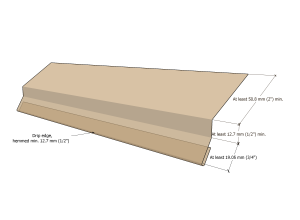 |
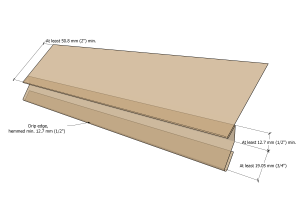
|
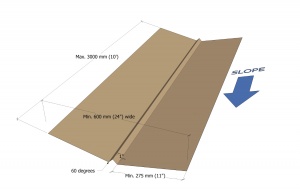 |
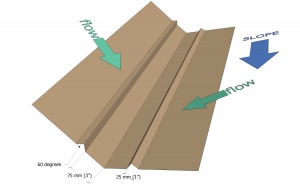
|
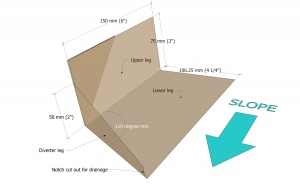
|
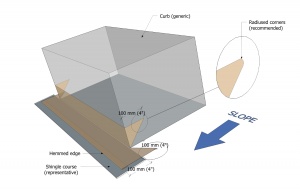
|
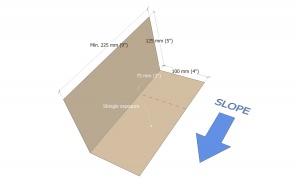
|
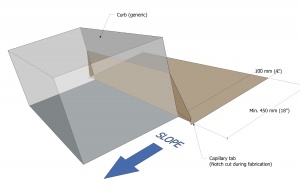
|
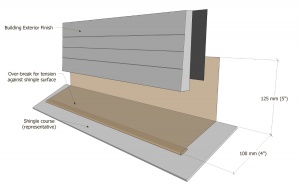
|
13.2.2.3. Pre-painted Finishes
- When a painted finish on linear metal flashing is specified, only SMP and PVDF pre-painted finishes are acceptable.
- Where Architectural Metal Roofing System adjoins an Asphalt Shingle Roof System, the adjoining linear metal flashing must have the same finish as the metal panels.
Section 13.3. Application
13.3.1. Guarantee Term Requirements
13.3.1.1. RoofStar 5-year and RoofStar 10-year Guarantee
- To qualify for a RoofStar 5-year or RoofStar 10-year Guarantee, all projects shall comply with the requirements in this Part.
13.3.2. All Systems
13.3.2.1. General Requirements for Linear Metal Flashing
- RoofStar-accepted pre-engineered securement systems must be secured according to the manufacturer’s specifications.
- All linear metal flashing installed over an organic substrate (i.e., wood) shall be separated from the substrate with a suitable underlayment or eave protection material (Ref. Section 8.2.).
- Unless otherwise provided for in this Part, mechanical fasteners used to secure linear metal flashing
- shall be spaced no more than 304.8 mm (12”) O.C.,
- must penetrate the substrate as specified in Article 3.3.2.1., and
- must be installed at least 88.9 mm (3-1/2") above the finished roof system surface.
- Where an adjoining waterproofing roof system is specified as part of the Contractor's scope of work, the work shall conform to the installation and seam requirements in the applicable waterproofing roof system Standard.
- Sealants must be tooled to positively shed water.
13.3.2.2. Seams
(The requirements in Article 13.3.2.1., "General Requirements for Linear Metal Flashing", shall be read together with the following requirements. See also Article 13.1.3.4.)
- RoofStar-accepted pre-engineered linear metal flashing may be joined together using seams specified for the accepted flashing.
- All linear metal flashing that is not pre-engineered must be seamed together following the requirements set out in this Article.
- All seams must allow for metal expansion and contraction.
- The seam and securement design must be approved by the Guarantor when the specified cap flashing material
- is steel or aluminum, and the material is thicker or heavier than 18-gauge, or
- is copper and zinc, and the material thickness or weight exceeds the weight or gauge requirements in Article 13.2.1.2.
- Unless otherwise stated in this Standard, all linear metal flashing (except step flashing)
- must be secured with at least two (2) fasteners, or with fasteners placed no more than 457.2 mm (18”) O.C.,
- must be secured (in exposed locations) with cladding fasteners, and
- may be secured (in protected locations) with nails or threaded fasteners that penetrate the substrate at least 19.05 mm (3/4”).
- Linear metal flashing secured with nails shall be
- covered by other (wall or curb) materials, or by adjacent flashings, and may not be left exposed to the weather, and
- installed at least 25.4 mm (1”) above the bottom edge of expected wall or curb finishes.
- All linear metal flashing (with the exception of metal valley flashing) may be overlapped rather than seamed.
- When lengths of flashing are overlapped, each overlap must be no less than
- 101.6 mm (4”) when fully caulked in the lap, and
- 152.4 mm (6”) when installed without caulking in the lap.
- When hidden metal clips are specified, they must
- be at fabricated from no less than 26-gauge flat metal stock.
- be fastened no more than 76.2 mm (3") from the return (connecting hook).
- engage the flashing by no less than 12.7 mm (1/2").
13.3.2.3. Cap Flashing, Counter-flashing, and Reglet Flashing
- The installation of cap flashing and counter-flashing specified for an adjoining waterproofing roof system or membrane gutter shall conform to the application requirements in the applicable waterproofing roof system Standard.
Part 14 - The Roof as a Platform
Section 14.1. Design
14.1.1. General
14.1.1.1. Scope
- The scope of this Part and the Standard shall be as described in Division A, Part 1.
14.1.1.2. Definitions
- Words that appear in italics are defined in the Glossary. Additionally, the following terms are used in this Part:
- Structures and Equipment means structurally supported or portable objects including (without limitation) wood or composite decks and walkways, planters, "amenity spaces" (inclusive of furnishings, hot tubs, gazebos, pergolas, and play areas), nets and wind screens, photovoltaics, satellite equipment, light standards, lightning rods, sculptures, pools, and other water features.
14.1.2. Guarantee Term Requirements
14.1.2.1. RoofStar 5-year and RoofStar 10-year Guarantee
- To qualify for a RoofStar 5-year or RoofStar 10-year Guarantee, all projects shall comply with the requirements in this Part.
14.1.3. All Systems
14.1.3.1. Coverage and Limitations
- Coverage under the RoofStar Guarantee shall be as described in Division A, Article 3.2.1.2.
14.1.3.2. Loads
- The building structure must be designed to support any live loads specified by the Code having jurisdiction, including loads from any covering, amenity space, structure or live loads superimposed upon the roof system.
14.1.3.3. Securement of Supported Structures and Equipment
- The Design Authority is responsible to specify the appropriate securement design of roof coverings, structures, and equipment, to resist Specified Wind Loads.
- Where structural securement is desirable or required, the superimposed structure or equipment must be secured to the structural support at least 203.2 mm (8”) above the drainage plane (See Part 12,"Penetrations and Curbs", and Part 3, "Securing the Roof Assembly").
14.1.3.4. Snow Guards
- While snow guards are not part of the roof system, snow guards
- should be designed so that they do not penetrate the roof system, and
- shall be designed in consultation with a registered professional skilled in the work concerned ("British Columbia Building Code", Division C, Section 2.2., "Administration").
- The decision to use snow guards, and their selection, is the responsibility of the Design Authority and neither the Guarantor nor the Contractor will accept any responsibility for damage to, or failure of, the roof system caused by the use or absence of snow guards.
14.1.3.5. Photovoltaic Panels
- Photovoltaic panels are considered "equipment" within the definitions used in this Standard, are not part of the roof system, and therefore photovoltaic panels
- must not penetrate the metal roof system,
- shall be deck-mounted,
- must be mounted at least 152.4 mm (6 inches) above the finished roof system surface, and
- shall be designed in consultation with a registered professional skilled in the work concerned ("British Columbia Building Code", Division C, Section 2.2., "Administration").
- No photovoltaic (PV) panels may be mounted on an Asphalt Shingle Roof System with a slope less than 1:4 (3” in 12”).
- All electrical connections, distribution cables, and related systems that penetrate the roof system must be flashed with purpose-made flashings incorporating weather-head fittings (see Article 12.2.1.2.; see also Subsection 2.1.8., Electrical Cables and Boxes).
Notes to Standard
© RCABC 2024
No reproduction of this material, in whole or in part, is lawful without the expressed permission of the RCABC Guarantee Corp.

